The Lawmatics Blog
Insights on legal marketing, automating the law practice, and legal tech in general
About the session
Behind every great client experience is a system quietly keeping things on track. The newest automation updates in Lawmatics build on that foundation, making it even easier to build and manage their automated workflows.
In this session, Devon Butler and Clare Struzzi walk step-by-step through what’s new. They cover trigger-based automations, appointment workflows, shared entry rules, and a simple way to organize everything in folders. Together, these improvements give firms even more control, flexibility, and time back in their day.
Webinar slide deck
It may not be a box of chocolates or a dozen red roses, but Lawmatics is here to deliver something even better this February: a new batch of features!

Kanban Board for Tasks
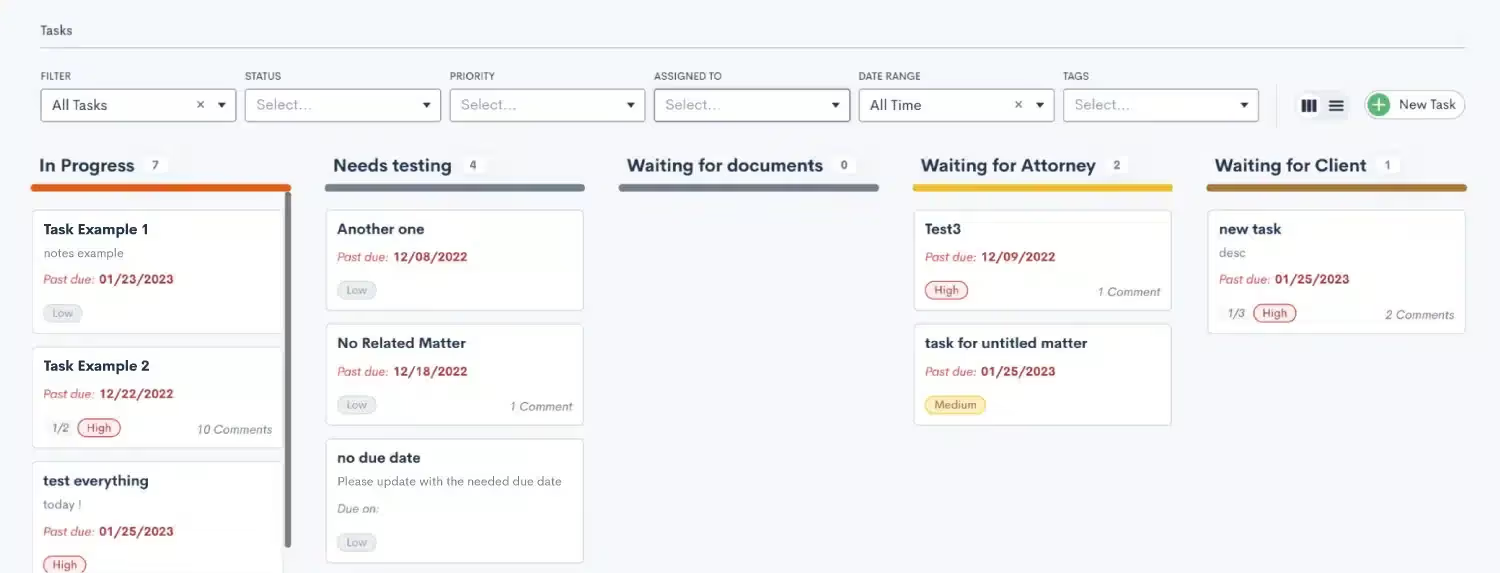
The Tasks dashboard now has the same Pipeline visualization you know and love. You can drag and drop Tasks through your sequence of statuses in the Kanban view. In addition to custom Task statuses, this feature will keep your Tasks more organized than ever. To select between Kanban or List view, simply go to the Tasks dashboard under your CRM tab and toggle the view selection next to the New Task button. Tasks will appear in the appropriate status column as they are created.Learn more about custom task statuses here.
Select Any/All Host Availability Option
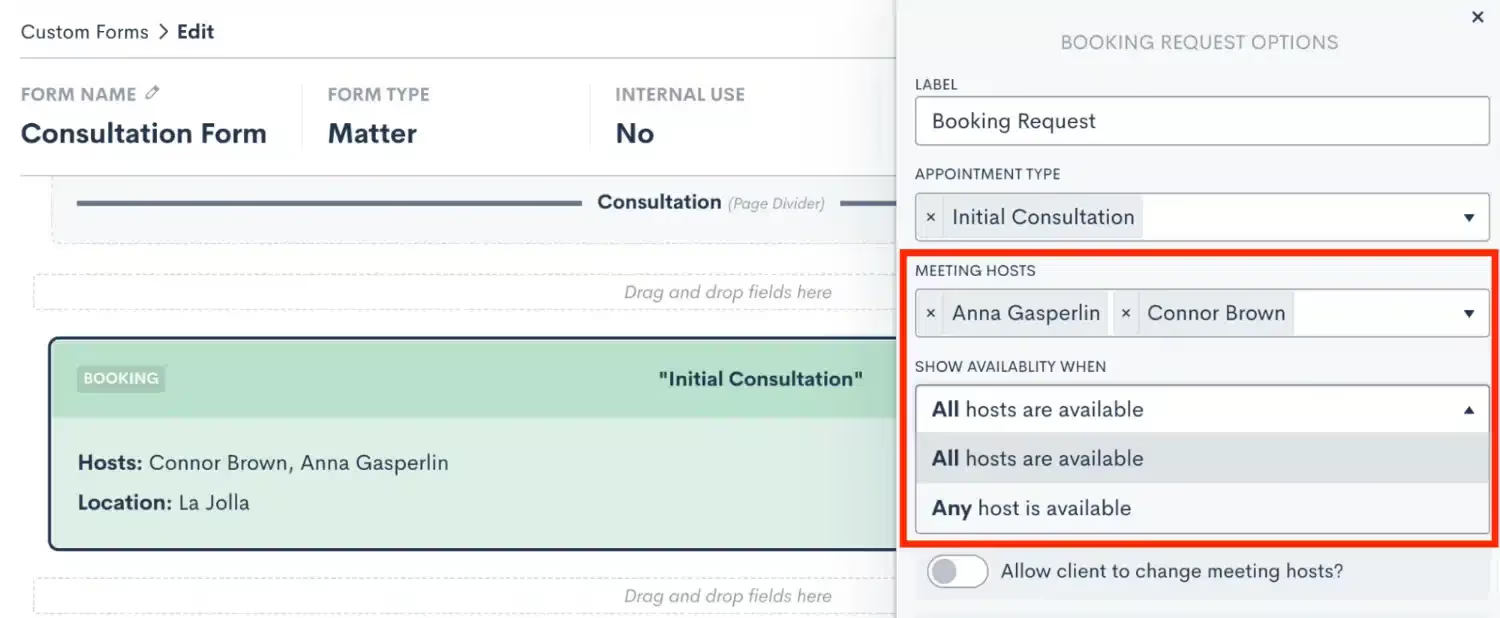
Automatic scheduling continues to be a fan-favorite feature among Lawmatics users. With this latest update, you now have availability options when booking for multiple hosts. Use the All option when both hosts must be available for the meeting, or use the Any option to showcase the soonest individual availability among the multiple hosts. You will find this option on your booking forms as well as custom forms.Click here to read up on booking forms.
Add Reschedule Link to Booking Forms

To make your automatic scheduling even easier, we’ve also added the ability to include a reschedule option in your booking forms. When a client wants to reschedule their appointment from a booking form, this new option allows them to simply reschedule their existing appointment. Eliminate the need to create an entirely new appointment when calendars move around. Choose whether or not to include the reschedule link in emails when editing your form.
Apply Trust Balance When Creating Invoice
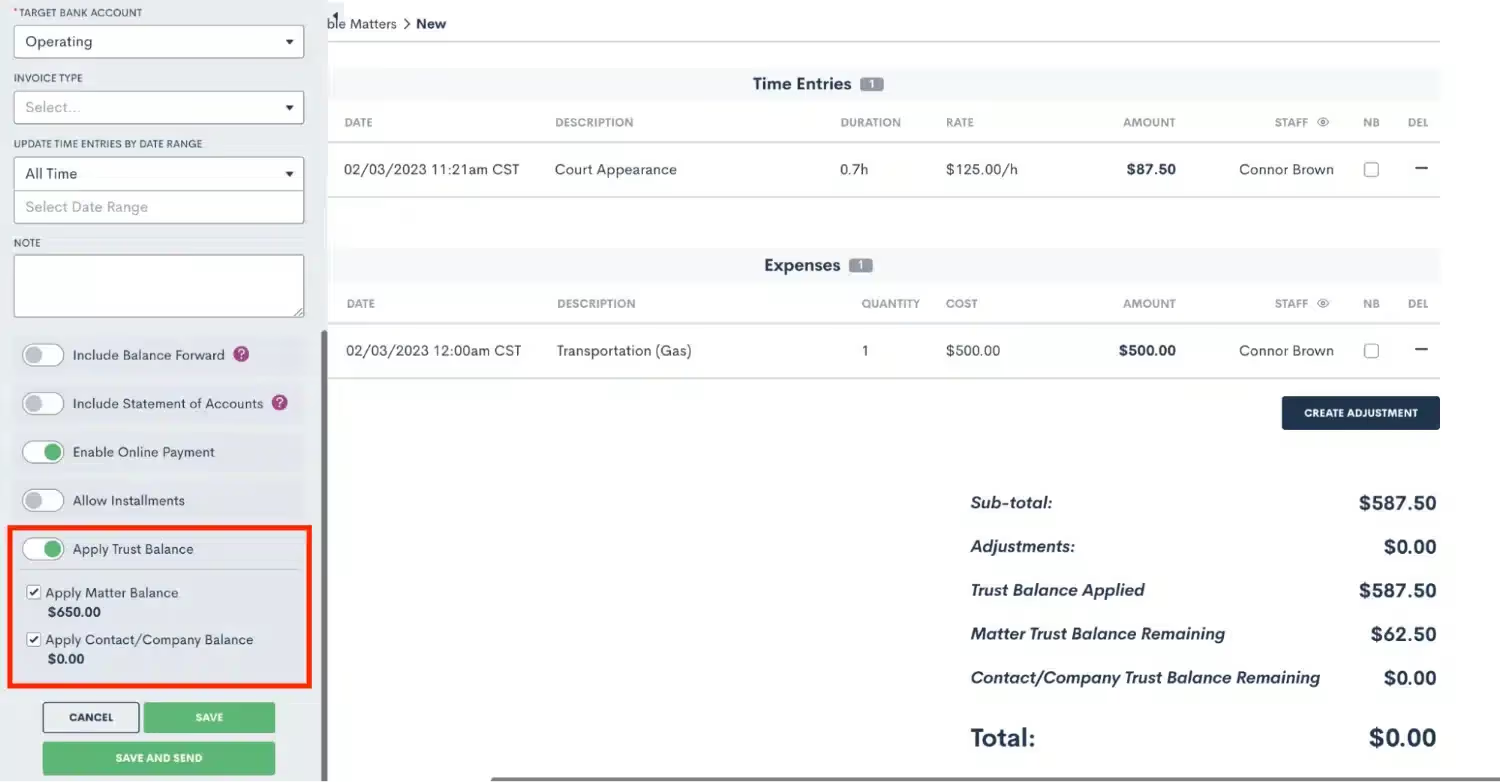
You now have the option to incorporate a matter’s trust balance when creating an invoice. After making all of your selections for the invoice terms, you will see the option at the bottom to Apply Trust Balance. This will be reflected on the invoice total to the right of the screen.Not yet using LMPay? Click here to learn how to get started.
Pay Invoice From Trust Account
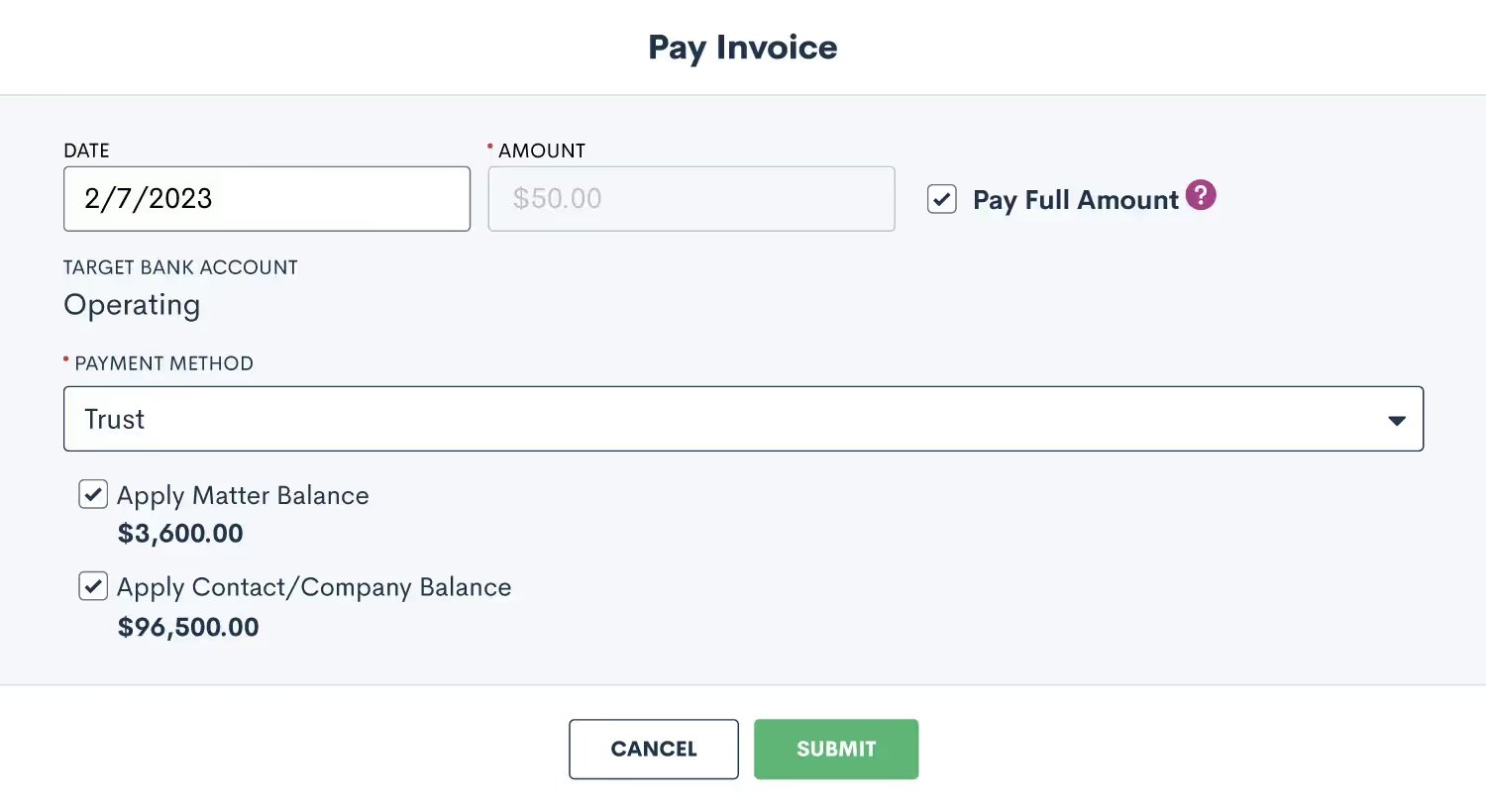
Similarly, when a client is sent an invoice they can also choose to pay the invoice themself using their trust balance. If they have a balance in their trust, that trust will appear as an option when selecting their payment method.Additionally, you can now choose if you would like to pay an invoice from the matter trust balance or the contact/company trust balance, or both. This can be used to pay an invoice from the trust account after the invoice has already been sent to the client.Click here to learn all about trust accounting in Lawmatics.
Billing Point of Contact Field

For our Time & Billing users, you now have the option to select one or multiple designated Billing Point(s) of Contact for your matters. This will default to the main contact on the matter, but you can easily select from any of that matter’s relationships as well. When creating and sending invoices, you have the option to select the Billing Point of Contact as the recipient for the invoice, making sure payment can be made by the proper contact(s).Read up on automating invoices here.
Also included in this release!
- New standard field: "Type of Billing" on matters
- Re-order custom activity types and expenses
- Zoom link merge fields available in email templates
- Email campaigns automatically remove duplicate email addresses
- Enhanced formatting capabilities in notes
From the bottom of our hearts, we have so much love for each and every one of our Lawmatics users! Hoping you feel the love with these latest features.
More and more lawyers are using customer relationship management — or small law firm CRM — software to help them keep track of their clients, and no–we're not talking about the old Rolodex systems of yore.With today's streamlined CRM systems, it has never been easier for lawyers to manage client data efficiently. Using a CRM, you’re able to create marketing campaigns tailored to a specific audience to identify prospective clients. You can prioritize the most important relationships by sorting your contacts by goal type. CRM insights can help your team understand your potential customers better so you can nurture leads and convert them into clients.
Understanding the role of legal CRMs
A legal CRM is an indispensable tool for law firms to serve their clients best. A law firm's CRM helps identify and track leads and provides powerful insights into better understanding your client acquisition process. These insights can include demographic information, pain points, and communication preferences, among other things. With this information, you can craft content that specifically addresses your target audience's needs and interests, increasing the likelihood that the content will resonate with them and lead to an inquiry. CRM solutions typically integrate with virtual receptionists, online intake forms, email marketing tools, and practice management software to be a centralized database for your law firm. A law firm CRM solution should be employed to help you tighten up your law firm's marketing efforts and client intake.
If it ain't broke, why does my law firm need a CRM?
Even if your law firm is already running efficiently, there are still many benefits that a CRM can offer. Here are some reasons you should consider investing in one:
- Improved Customer Service: With easy access to contact information, documents, notes, and other data, lawyers can respond quickly to clients and build stronger relationships.
- Enhanced Data Security: Law firms store confidential client information that must be stored securely. A CRM helps ensure this data is safely contained in one secure system – both online and on-premises
- Better Marketing Automation: Identifying target markets and sending automated newsletters or emails through the CRM will enable you to engage potential clients more effectively.
- Gaining Insights: By accessing analytics from a single platform, law firms can comprehensively view their operations and make data-driven decisions based on facts and figures.
Must-have features of a legal CRM software
To be effective, a CRM should bring value to your law firm by having intuitive navigation, fast searching capabilities, and the ability to sync with your existing software. Here are the top five features every legal CRM should have:
- Track and create audience segmentation: A great legal CRM should provide the ability to track metrics such as acquisition, engagement, conversion rates, and other important user data. It should also have advanced segmentation capabilities so you can target specific subsets of clients.
- Engage potential clients: Many legal CRMs will offer email automation features that allow you to send targeted campaigns and emails to potential clients. Doing so helps increase brand awareness and drives conversions.
- Manage client activity and communications: A versatile CRM should facilitate communication between all stakeholders in the legal process, from attorneys to paralegals, assistants, and clerks. Advanced task management capabilities help keep everyone informed while keeping data organized.
- Keep your client data records organized and updated: The best legal CRMs allow you to store contact information, documents, notes, and more in one secure space – both online and on-premises. Keeping these centralized ensures that all data is easily accessible when needed.
- Sort your contacts with criteria tailored to your law firm: Advanced search filters enable lawyers to quickly find cases based on criteria such as area of practice, case type, or client status.
How to choose a CRM for law firms
Choosing the right CRM system for your law firm is a crucial decision. Consider your firm’s current infrastructure, team size, and budget when evaluating to ensure compatibility.Opt for a cloud-based CRM that is both easy to use and robust enough to track leads, acquire data, and nurture relationships effectively. Additionally, prioritize security features such as access rights on multiple levels to reduce the risks associated with data breaches. With the right choice of CRM system in place, you will have better control of your data while enjoying greater management efficiency.
What CRM do law firms use?
Lawyers use the following CRM software to help manage client relationships:
- Excel - Microsoft's popular spreadsheet application allows users to track, visualize, and analyze data easily. Excel data can easily be overwritten, become unwieldy, and may not serve a growing law firm.
- Lawmatics - Lawmatics was designed specifically for law firms to manage cases from intake to close in one unified platform.
- Hubspot - A leader in the customer relationship management space, Hubspot offers powerful analytics that allow users to understand how customers interact with their business. However, Hubspot is not specific to the legal industry and is often too robust for smaller law firms.
- Salesforce - This non-legal-specific CRM system provides robust features, including workflow automation, integration with other services like Outlook or Google mail, and detailed reporting capabilities designed for enterprise businesses. That said, Salesforce lacks the functionality that an attorney’s office requires for managing client relationships and case information.
Stay in touch with a legal CRM
Law firms increasingly turn to CRMs for their operational efficiency, improved customer service, and better marketing capabilities and results. A good CRM can also help law firms gain valuable insights into their business operations and make data-driven decisions. If you want to keep up with the competition and maximize your law firm's performance, consider investing in a legal CRM today. Book a demo with us now and find out how Lawmatics can help!
According to the 2020 American Bar AssociationProfile of the Legal Profession Report, there are more and more people of color becoming lawyers every year. Despite the increase, African Americans currently make up only 5% of all lawyers in the US. Compared to their presence in the overall population in the United States (13.4%), African Americans are substantially underrepresented in the legal profession. Strides in representation are key to a diverse legal arena, ensuring just outcomes for more communities, reduction in bias, and lower barriers to entry into the legal profession for people of color. To that end, we’re celebrating nine trailblazing African American attorneys who didn’t just persevere, but downright shaped the world as we know it with their tenacity and steadfastness.
1 Jane Bolin

Kicking off the list is the incredible Jane Bolin who was the first of many things. Jane was not only the very first black judge in United States history, but also the first black woman to graduate from Yale Law School, the first black woman to join the New York City Bar Association, and also the first black woman to join the New York City Law Department. Initially restricted from enrollment at Vassar College, which refused admission to black students at the time, she instead enrolled at Wellesley College in Massachusetts and graduated in the top 20 of her class. After being told by a career advisor at Wellesley she could never make it into Yale Law school as a black woman, she was nevertheless accepted and graduated in 1931. She served 40 years as judge of domestic relations court where her appointment was renewed a whopping three times. During her time as a judge, she was a strong advocate for children's rights and education, and fought to combat racism.
2 Johnnie Cochran

Perhaps one of the most familiar names in legal history, Johnny first gained public recognition for his masterful defense of OJ Simpson. In addition to OJ Simpson, other celebrity clients he represented included Michael Jackson, James Brown and Tupac. His skillful yet controversial strategy that ultimately won OJ’s acquittal was demonstrating the ineptitude of the LAPD, and that OJ had been framed due to racism.Before representing celebrities, however, Johnnie had a modest upbringing in Louisiana during the Jim Crow era. His great-grandparents were slaves and his grandfather was a sharecropper. Thanks to his parents' strong work ethic, he pursued his education at UCLA and after, attended Loyola Law School. Following passing the bar exam, Johnnie was hired as an attorney for the Los Angeles City Attorney’s office in traffic court. On his very first day in court, he won 28 traffic ticket cases. By the mid-1960’s Johnnie was one of Los Angeles’s top trial lawyers. Over the years Cochran became well known for his theatrical courtroom style which often included catchy rhetoric like "If it doesn't fit, you must acquit!” He established himself as the “go-to” attorney in Hollywood when you needed strong representation. By the 2000’s Johnnie was worth tens of millions.
3 Barack Obama

Not only was he the first black president in history in 2008, but he was also a Harvard Law School graduate, and the first black president of the Harvard Law Review. Following law school, he worked as an associate attorney with an Illinois law firm for three years, staying true to his passion for representing discrimination and voting rights cases. In 1993 he was offered a position to teach constitutional law at the University of Chicago Law School where he remained for 12 years. Three years into working as a constitutional law lecturer, he was elected to the Illinois Senate. He continued to rise in politics and eventually was elected to the U.S. senate, making him the third African American elected in US history. In 2007, he began his presidential campaign and became the first-ever black president. He was elected a second time in 2013, and remains one of the most celebrated presidents in history.
4 Willie Gary

They call him the “Giant Killer” for a reason— Willie Gary famously took down corporate giants in wins that were seemingly impossible. Perhaps his most famous verdict was winning a 240 million dollar settlement against Disney for two men who claimed their original idea for the Wide World of Sports complex was stolen. Beyond the Disney case, he also won many other notable settlements valued over a whopping 30 billion dollars. Before he made national headlines, however, he opened the very first African American law firm in his town in Florida. In 1994 he formed the Gary Foundation which is dedicated to the education of young people and drug prevention. He continues to practice law and also delivers motivational speeches across the country.
5 Charles Hamilton Houston
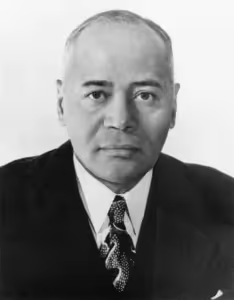
He is known as the “The Man Who Killed Jim Crow” for his significant contribution to ending segregation. In 1922, he was the only black student in his class and was no stranger to segregation himself. The son of a lawyer, he was no stranger to law and went on to follow in his father’s footsteps. He graduated from Harvard Law School and joined his father’s law practice soon after. In addition to fighting Jim Crow laws is known for being a prominent mentor for black attorneys. He encouraged a generation of black lawyers to fight for equality and use the law to combat discrimination, most notably Thurgood Marshall who was the first black supreme court justice.
6 Fred Gray

Fred worked directly with Martin Luther King Jr as his first civil rights attorney and defended Rosa Parks for her famous refusal to sit in the back of a segregated city bus, and is still alive today at 91 years old. He played an important role in many historical civil rights cases including Browder v Gayle, which affirmed that bus segregation is unconstitutional.He is arguably one of the most important African American lawyers in history for his significant career as a landmark-setting civil rights attorney. He was awarded the Soaring Eagles Award in 2003 from the Minority Caucus of the Association of Trial Lawyers of America which recognizes the difficulties that lawyers of color face in their pursuit of success.
7 Star Jones

Star Jones was a household name in the late 90’s to the 00’s as she was one of the original hosts of The View. Often marked as controversial initially, the concept of The View was a multi-generational group of co-hosts discussing hot topics. Each panel member had distinct and varying ideologies and viewpoints which could lead to heated conversations. The show is still a success to this day largely in part to Star’s legacy. Before she was a part of daytime programming, however, Star was a prosecutor with the Kings County Attorney’s Office in Brooklyn. Eventually she was promoted to senior assistant district assistant district attorney. Because of her no-nonsense approach and charisma, she soon found herself starring in her own court show, which was an attempt at another version of The People’s Court and Judge Judy. Despite the show being canceled after only one season, Star was officially the first black court show judge in history.
8 Charlotte E. Ray

Charlotte E. Ray was the first African American woman admitted to the bar in the United States. Ray studied law at Howard University, becoming the first woman admitted to the District of Columbia bar in 1872. She’s said to have applied to the Howard School of Law with the name “C.E. Ray” so that her application would be judged on its merits and not on her gender. Ray’s most well-known case came in 1875, representing Martha Gadley seeking a divorce from her abusive husband. She successfully argued in the case before the District of Columbia Supreme Court. Although her legal career was shortened by prejudice, her dedication to public service extended into her later career as a public school teacher and civil rights activist.
9 Macon Bolling Allen
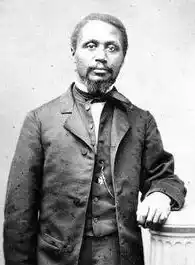
Macon Bolling Allen was the first African American admitted to the bar and the first Black judge in the United States. He was a self-taught attorney, studying for the bar while working as an apprentice at the law firm of a white abolitionist. Allen was a member of the bar in Maine and Massachusetts, having been initially denied entry to the Maine bar on the grounds that he “was not a legal citizen.” He was named as Justice of the Peace in Middlesex County in 1947. In 1868, he co-founded the first Black-run law firm in the United States alongside Robert Brown Elliot and William J. Whipper. Allen also served as a judge in South Carolina during Reconstruction.
Paving the way for future generations of lawyers
Thanks to these revolutionary lawyers who paved the way so courageously, the legal industry is significantly more diverse than it was 100 years ago. Yet there is still work to be done to improve diversity in the legal profession. Black lawyers still remain the least represented ethnicity in the United States, and diversity is important in society as a whole—and the legal world is no different. Diversity benefits both lawyers and their clients since it provides different perspectives and promotes a more varied dialogue. When mixed with the right legal tools like Lawmatics, a diverse law firm can take on a new and modern approach to law that values all backgrounds and life experiences, and prioritizes client relationships. Are you ready to see how Lawmatics all in one legal client intake, law practice CRM, marketing automation, and legal billing software can take your client relationships to the next level? Sign up for a free demo today!
You didn’t sign up for a career in web design. Nevertheless, taking ownership of your law firm’s website architecture is a crucial element of growth. Website optimization is both the biggest component and the biggest obstacle of most online marketing strategies for law firms. If a potential client does only one thing to evaluate your law firm, they will look at your website. That’s why law firm websites need to have clear information presented in a clear way. We’re going to break down seven web pages your law firm definitely needs, with the help of real examples from Lawmatics customers. These examples will demonstrate how your website can tell your firm’s story in showcasing its history, personality, approach, and efficacy.
1 Home Page
First impressions are vital. The Home page will be the first impression for 75% of your website’s visitors. As most if not all of your advertising and online traffic will direct to this page, you’ll want to make sure it’s welcoming, informative, accessible, and sets the tone for your brand. The first goal of the Home page is to communicate what you do; the second goal is to show how you do it. It describes the law firm’s values and practice areas. It’s also an opportunity to validate the quality of your firm’s legal services. An accurate homepage is the best way to qualify leads: visitors who aren’t suitable clients for your service will self-select and not overload your intake process.
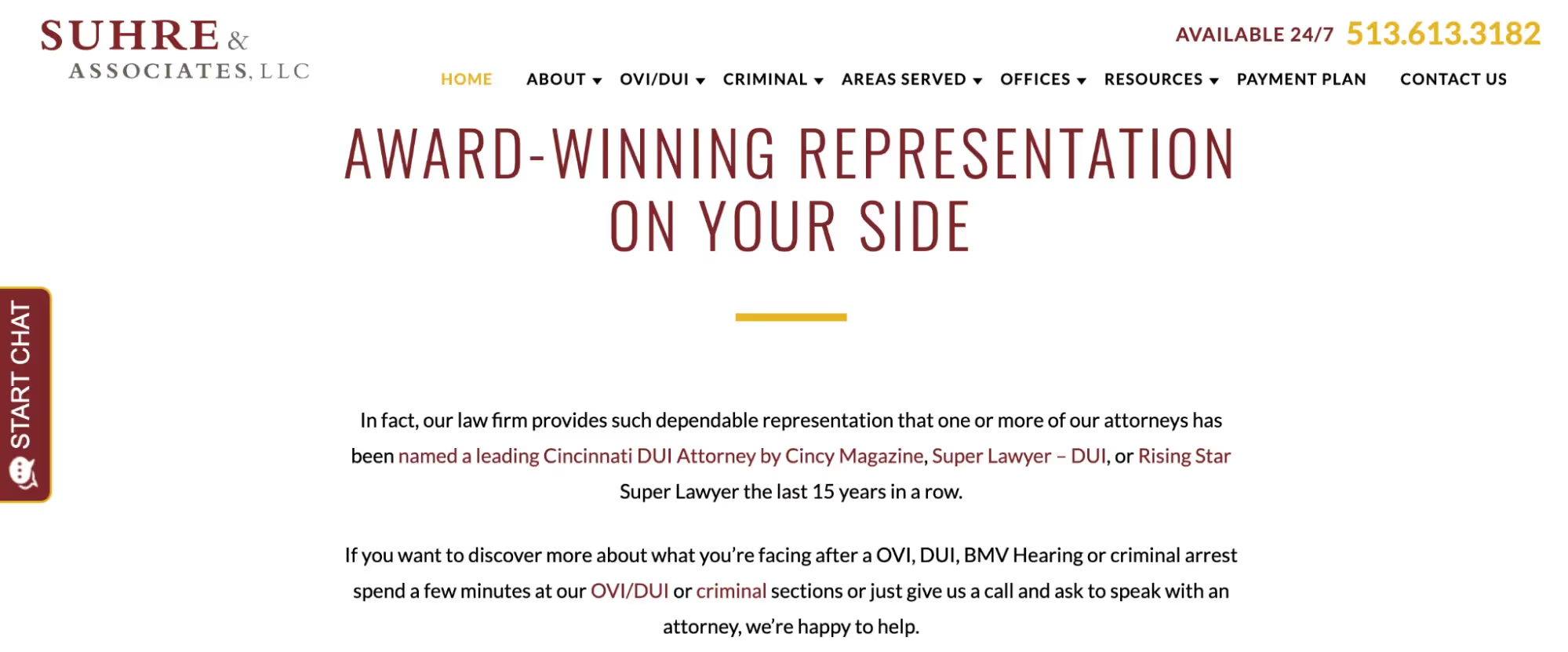
The Home page of Suhre & Associates, LLC highlights the firm’s client testimonials, case studies, and awards. The takeaway from this page is that Suhre & Associates has a history of sustained success representing clients in OVI/DUI and criminal law. After someone reads your Homepage, they shouldn’t necessarily know every little thing about your firm. They just have to know that you’re effective at what you do.
2 About Us
The About Us page is the second-most visited page for many websites, and should include the most detailed information about your law firm. It’s a great place to dive deeper into the firm’s values and story. No matter the size of your firm, tell your firm’s story on this page through its people. Take Marc Brown Law Firm as an example. As a smaller firm, establishing a personal connection is crucial for Marc Brown. That’s why the About Us pages contain detailed biographies, bar admissions, education, professional memberships, and community involvement. This level of personal detail helps potential clients envision Marc as an attorney they can trust.
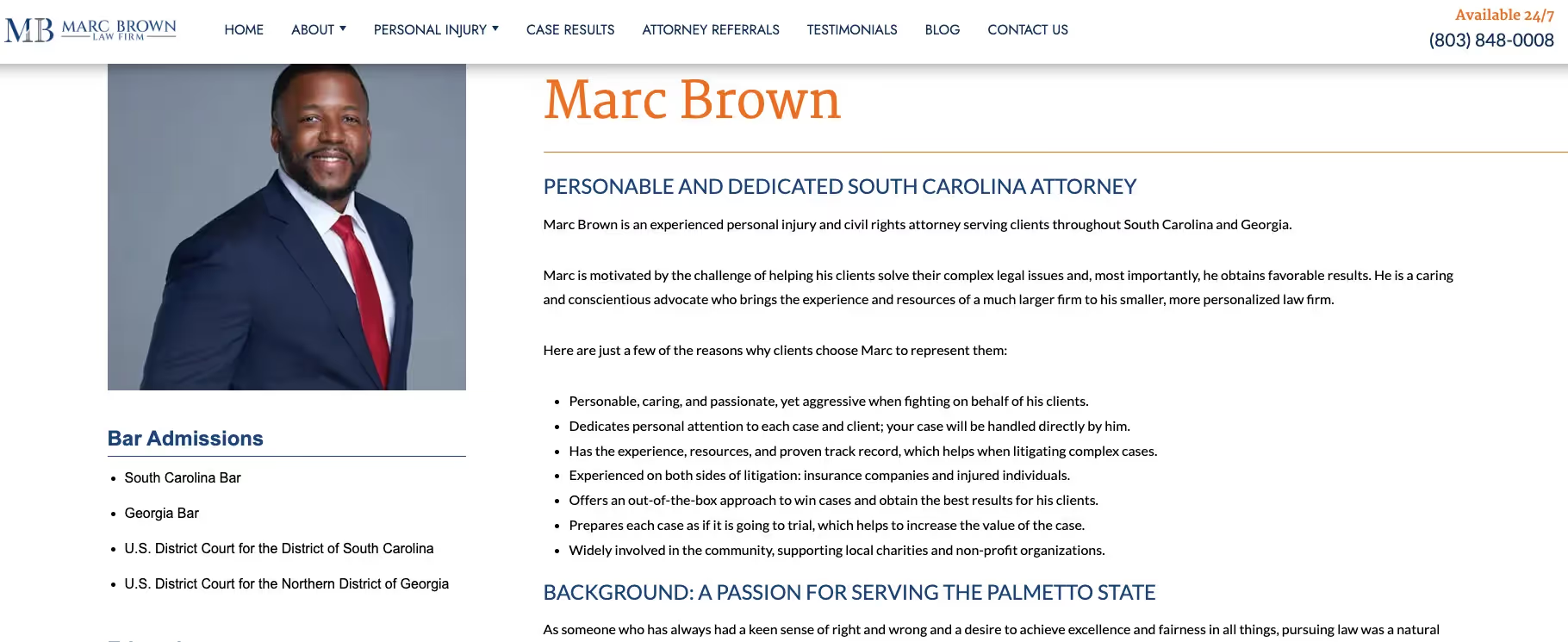
For a large national firm like Harris Federal Employee Law Firm, this may look a little different. In addition to attorney and staff biographies, Harris’s About Us page highlights its measurable impact. This page can effectively assuage concerns a potential client might have about hiring a large national firm. By including the “99% success rate” statistic alongside employee biographies, this page tells potential clients that the firm isn’t an impersonal legal machine; it’s a firm staffed by highly effective and approachable people.
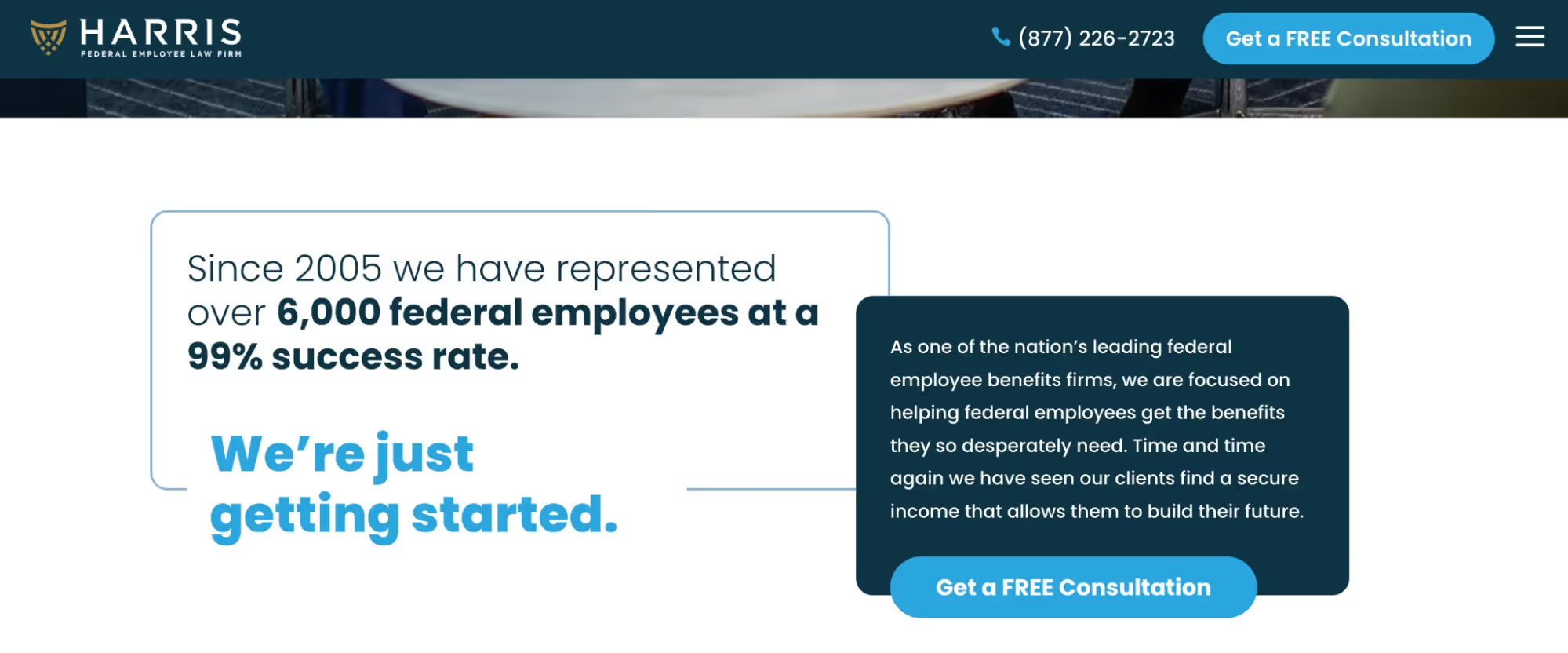
Ultimately, the About Us page is your chance to make the case for why your firm is different from all the other firms. What’s the thing that really sets you apart from your competitors? What makes you stand out?
3 Practice Areas
The Practice Area page describes the services your firm offers. Not every client is going to know the exact service they need. That’s why the Practice Area page is both a lead qualifier and an educational opportunity. A potential client might need a way to secure assets for their family, but not know whether they need a will or a trust. In this example from Proven Law PLCC, the Practice Area page provides easily-digestible information about legal intricacies potential clients may not know. This type of Practice Area page establishes the firm as an approachable authority in the area of estate planning and tax law.
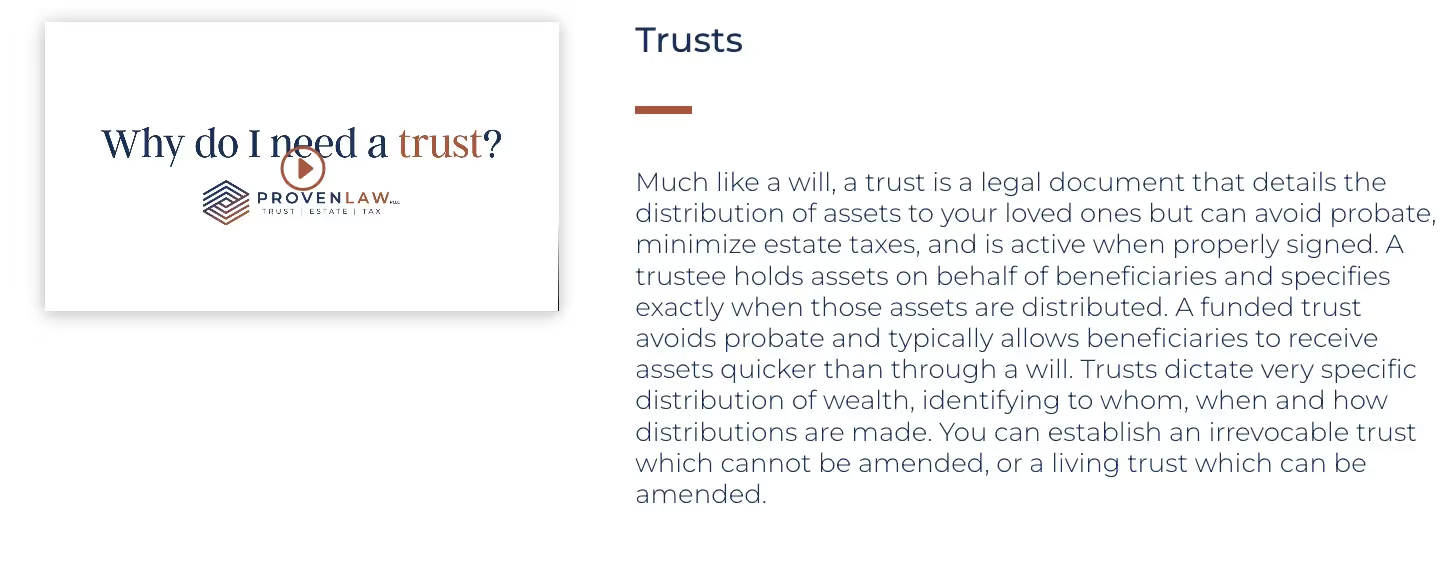
If your area of practice has several subdivisions or areas of focus, consider adding web pages dedicated to each of those subdivisions. Incorporate specific phrases like “Wills & Trusts” into your website architecture so visitors can easily identify a service they may already have in mind. Make your website more navigable by not solely relying on overly broad titles like “Estate Planning.”
4 Legal Resources
A Legal Resources page employs dynamic educational content. While a Practice Area page may be more concerned with definitions and outcomes, a Legal Resource library shows how your firm thinks. It’s a blend of your expertise and your personality. Triangle Smart Divorce maintains a blog that educates visitors on legal process, practice area insight, and advice for navigating divorce. They also include downloadable resources like e-books and FAQ guides.
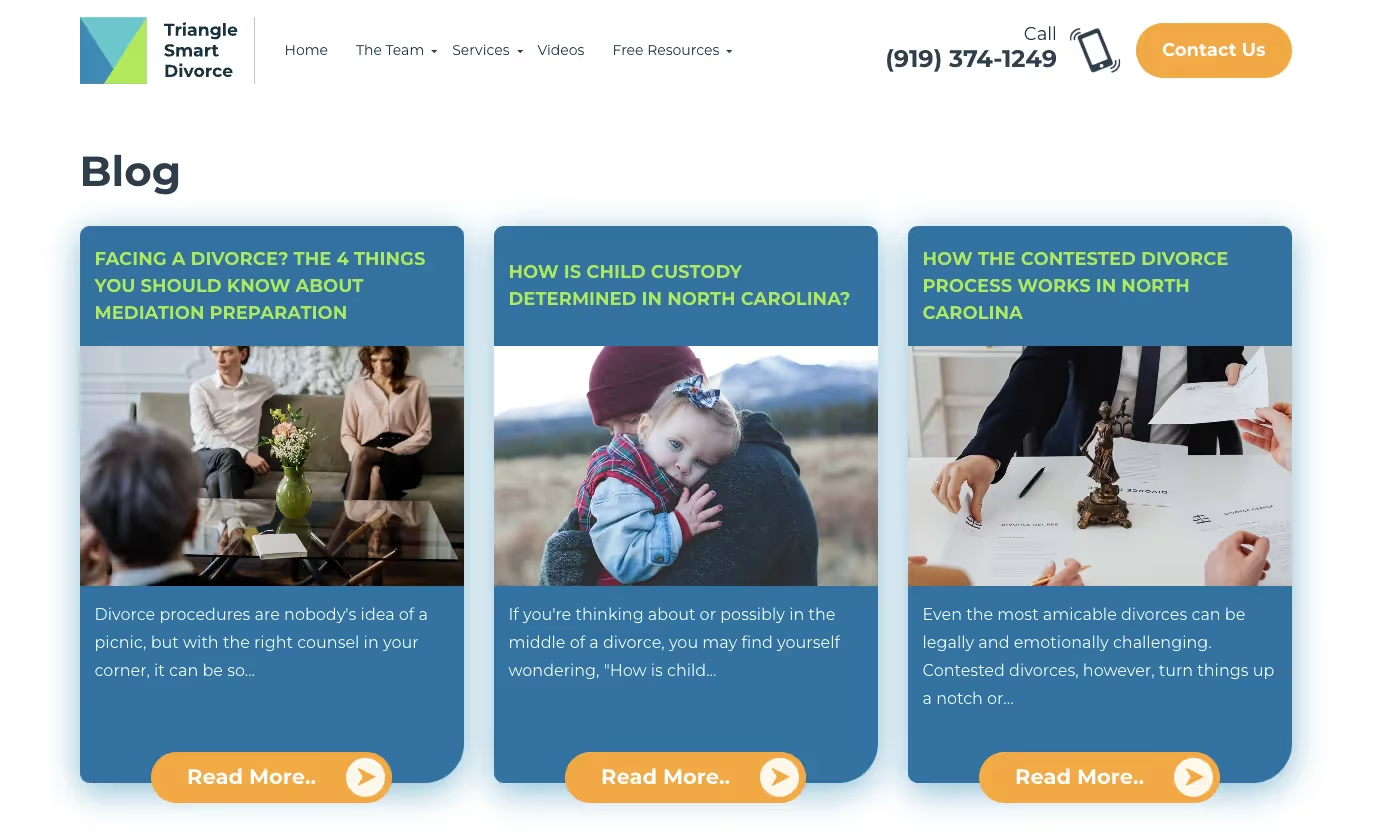
5 Case Studies and Client Testimonials
Your firm may be the best, but a prospective client won’t simply take your word for it. Case studies and client testimonials demonstrate the effectiveness and quality of your firm’s services and the overall experience of working with you. The stories of people you’ve previously helped allow potential clients to imagine themselves hiring your firm. Pacific Workers’, The Lawers for Injured Workers, showcases client testimonials in both text and video.
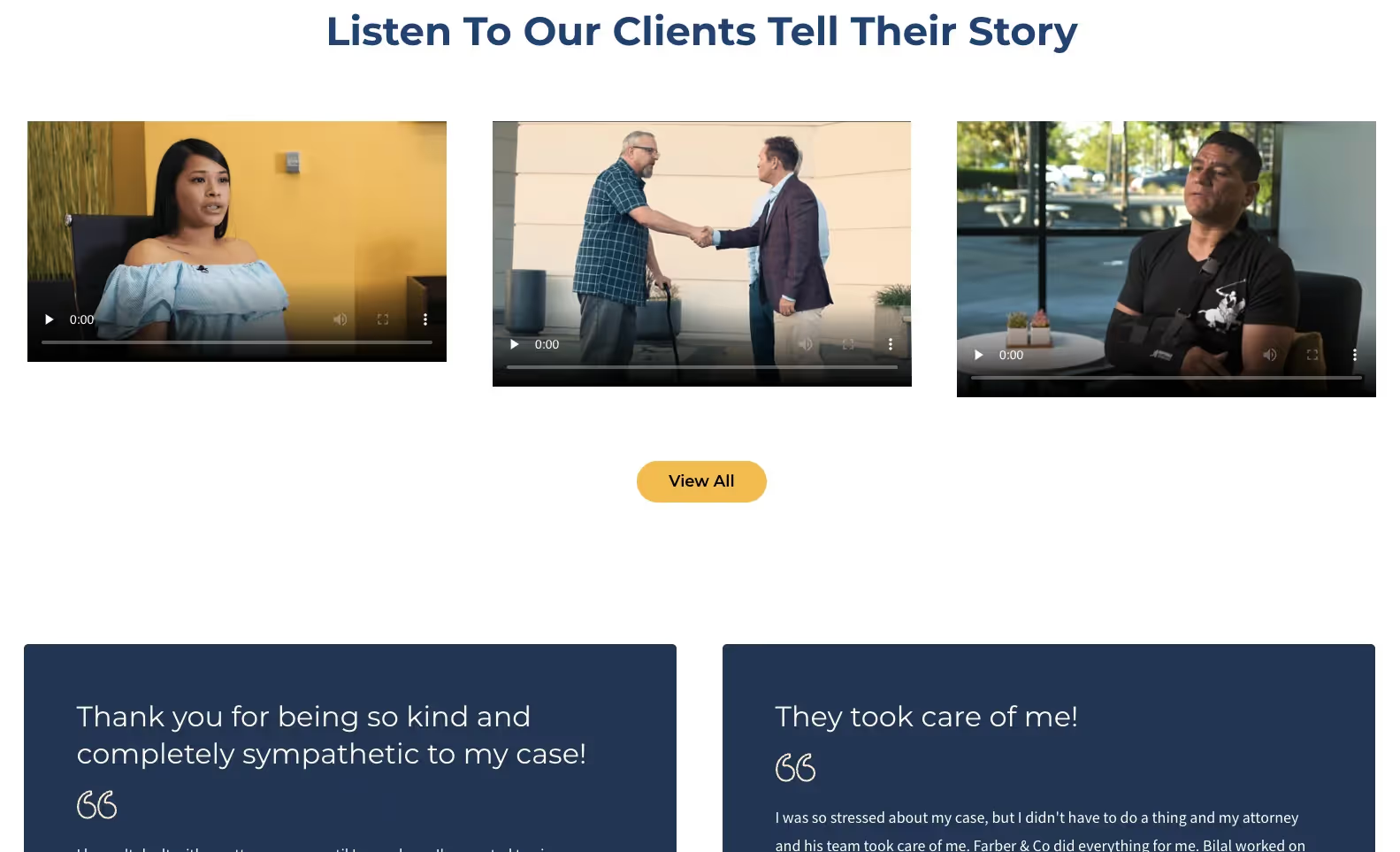
Client testimonials and case studies create what Robert Cialdini called “social proof.” Humans don’t make decisions based purely on statistics and compelling copy. We seek social feedback to shape our understanding of what’s good, normal, and important. If we see that another person in our position hired your firm and it worked out, we can imagine ourselves also hiring your firm and having a positive experience. Pacific Workers’ supplements these qualitative reviews with a page dedicated to quantifiable results. The workers’ compensation field is heavily driven by outcome. It’s important to show potential clients that they will have a high quality experience and get results. This website strategy may not be applicable to other practice areas, but it’s a good example of a law firm designing their website to meet their unique needs.

Social proof and quantifiable results are crucial pillars in making a buying decision. Transparent exhibitions of your results and process give potential clients permission to trust your firm.
6 Contact Us
The Contact page must list your firm’s phone number and email address. It should also have a form for visitors to provide their contact information if they’d like to submit an inquiry or sign up for updates from your firm. Sterling Immigration Ltd. also uses this Contact page to list their multiple office locations. If your firm has several office locations, or operates in multiple states or jurisdictions, you may want to consider creating a separate Locations page that explains any differences between office locations.
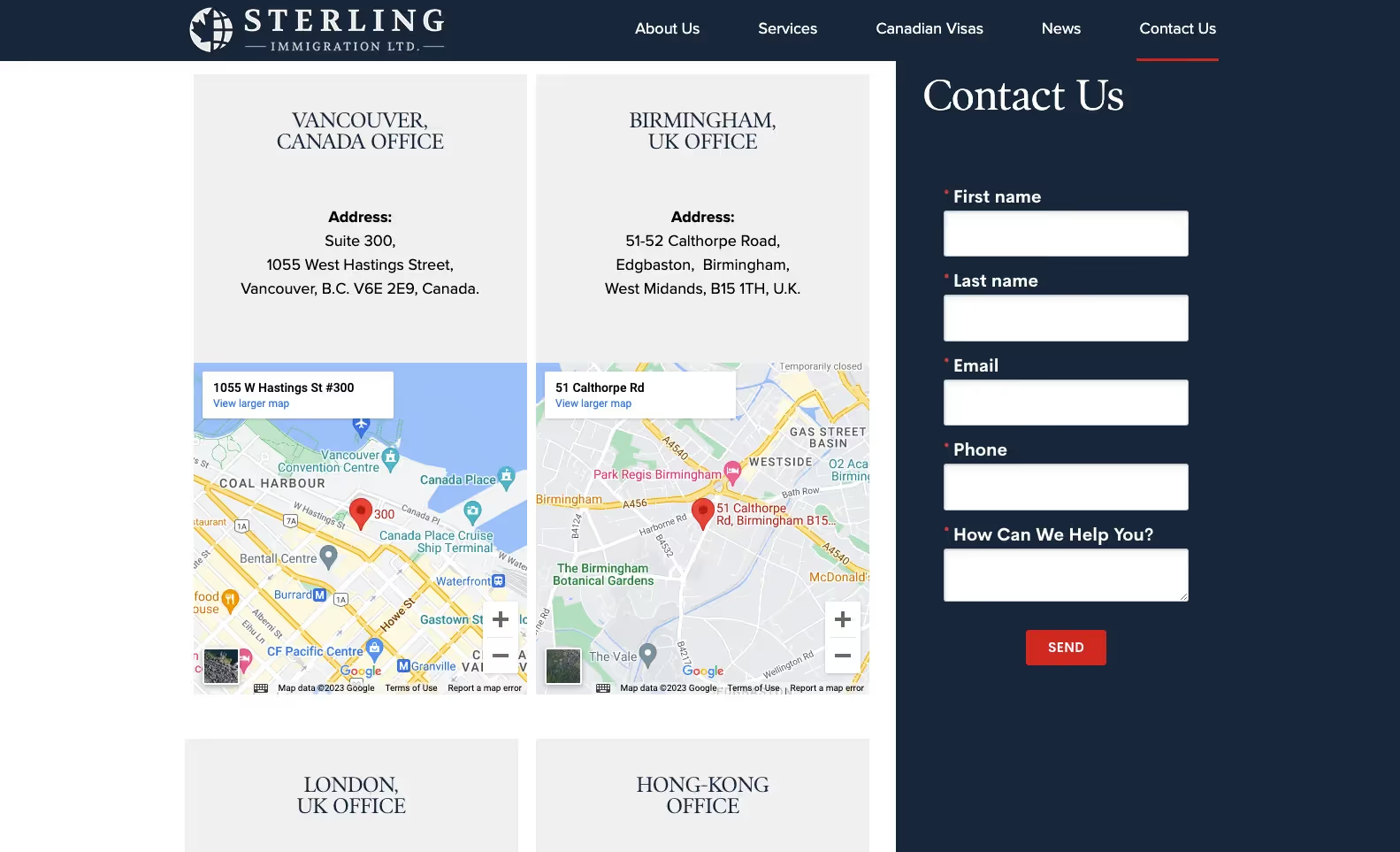
7 Frequently Asked Questions
The FAQ page is where you break down your process. If a visitor wants to engage your firm, how do they start? What happens during the initial consultation? How do you determine pricing and rates? What should a client expect while your firm handles their matter? Kraayeveld Family Law uses their FAQ to walk through the process of hiring a divorce attorney. It examines qualifications, ethical conflicts for attorneys, timelines, and some simple definitions. If potential customers can relate to the questions and are comforted by the answers, the FAQ page can be where they start to picture themselves as engaged clients.
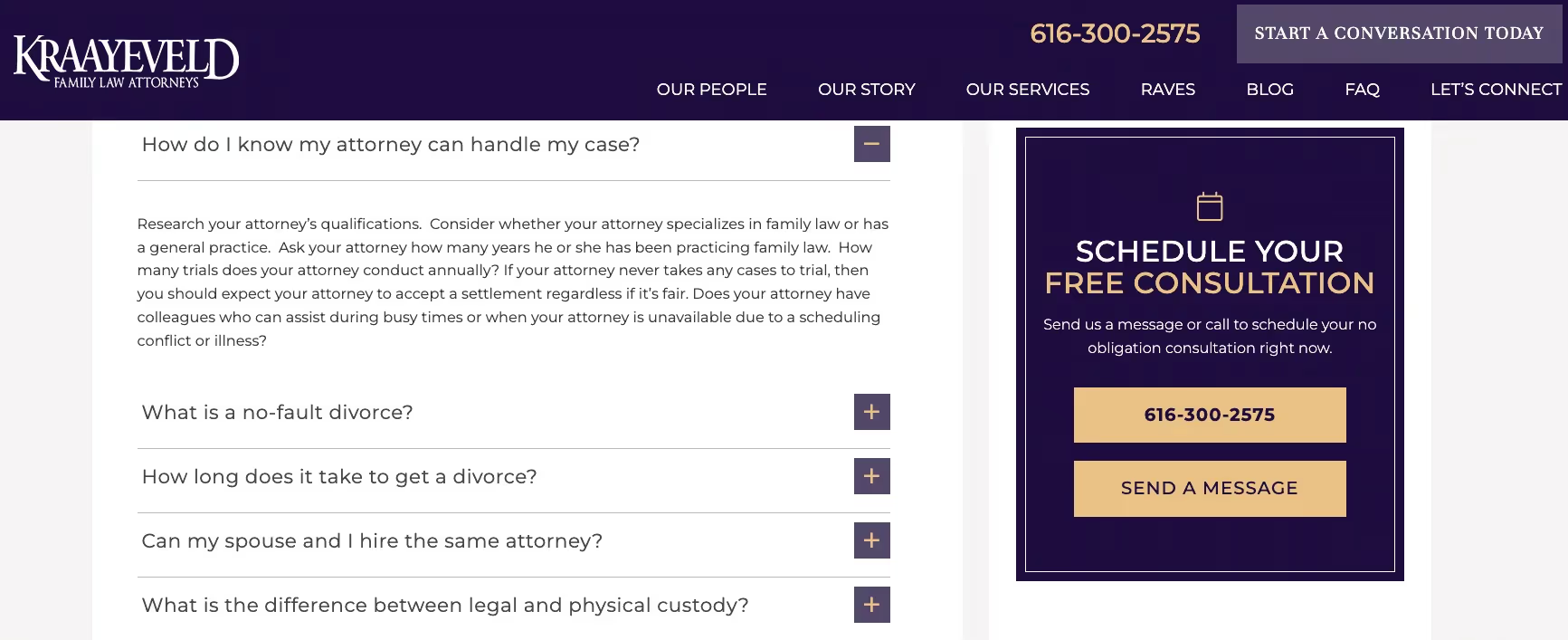
Takeaways
These seven web pages are key building blocks for any law firm website. As you build and add to these pages, consider the client experience. Put yourself in the shoes of a potential client and ask what information they would find helpful when hiring an attorney. Ask yourself how they’re feeling. If your clients are often stressed because of their legal matter, consider how your website can be more approachable, comforting, and calming. Additionally, ask what makes your firm unique. Whether it’s your personality or how you deliver your service, embrace what makes you stand out. Make sure that unique element is represented on your website.Every web page is a proof point for your firm. Whether it’s your subject matter authority or history of proven outcomes, each page makes the argument that your firm is effective and trustworthy. In a highly competitive legal landscape, a well-constructed law firm website reinforces credibility, increases engagement, and results in more leads taking action to hire your firm.A website is just one element of a comprehensive law firm marketing strategy. If you feel overwhelmed by managing your law firm marketing and intake process, Lawmatics can help. Schedule a demo today to see how the #1 client relationship management platform can work for your firm.

Lawmatics Time Tracking and Billing consolidates essential case management features into the platform that you already know and love. With the introduction of LMPay, you can now seamlessly collect your consultation fees through Lawmatics as well. Whether you are looking to implement the full suite of Billing and Time Tracking into your process, or use LMPay for collecting consultation fees, Lawmatics has all the tools you need to make that happen.Each of the aforementioned billing features make it easy to get paid quickly and easily while facilitating an exceptional client experience.
Introducing LMPay
If you collect or intend to collect consultation fees from prospective clients, LMPay is your go-to payment solution. LMPay is quick to set up, easy to use, and accessible without any additional fees on your Lawmatics subscription. LMPay also boasts no fees (or hidden fees) for ACH and competitive industry rates for credit card payments.
Registration
To use LMPay, you will first need to register your firm and complete a brief application process. Begin by opening Lawmatics and navigating to the Settings menu. Once there, select LMPay and you will then see a screen similar to the one shown below.
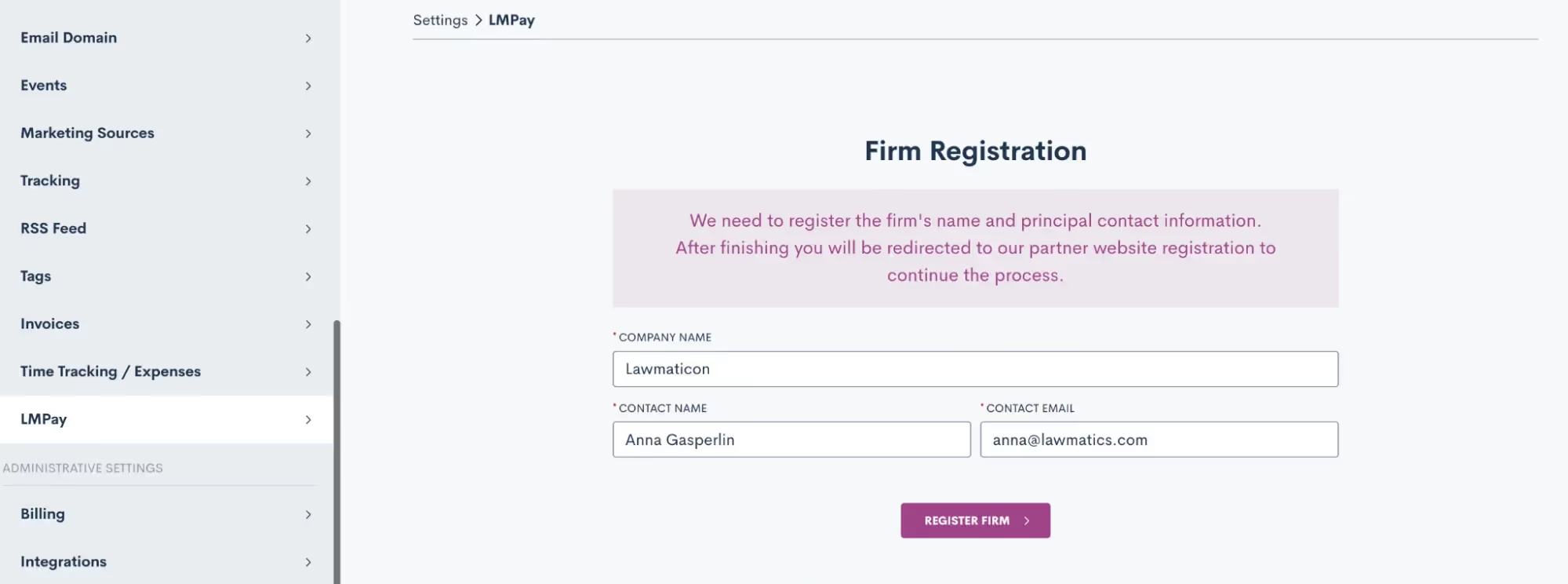
Upon initiating the registration process, the system will walk you through a sequence of steps to submit your application. The review process generally takes one to two days. Once approved, you’ll have complete access to LMPay.
Features
Payment Gateway
One of the key features of LMPay is the Payment Gateway, a tool to collect consultation fees. The Payment Gateway can be added to any Custom Form or Booking Form, of a seamless step in the consultation booking process.Drag and drop the Payment Gateway field from the Advanced section in the Form Editor, and then click on it to set your payment terms.
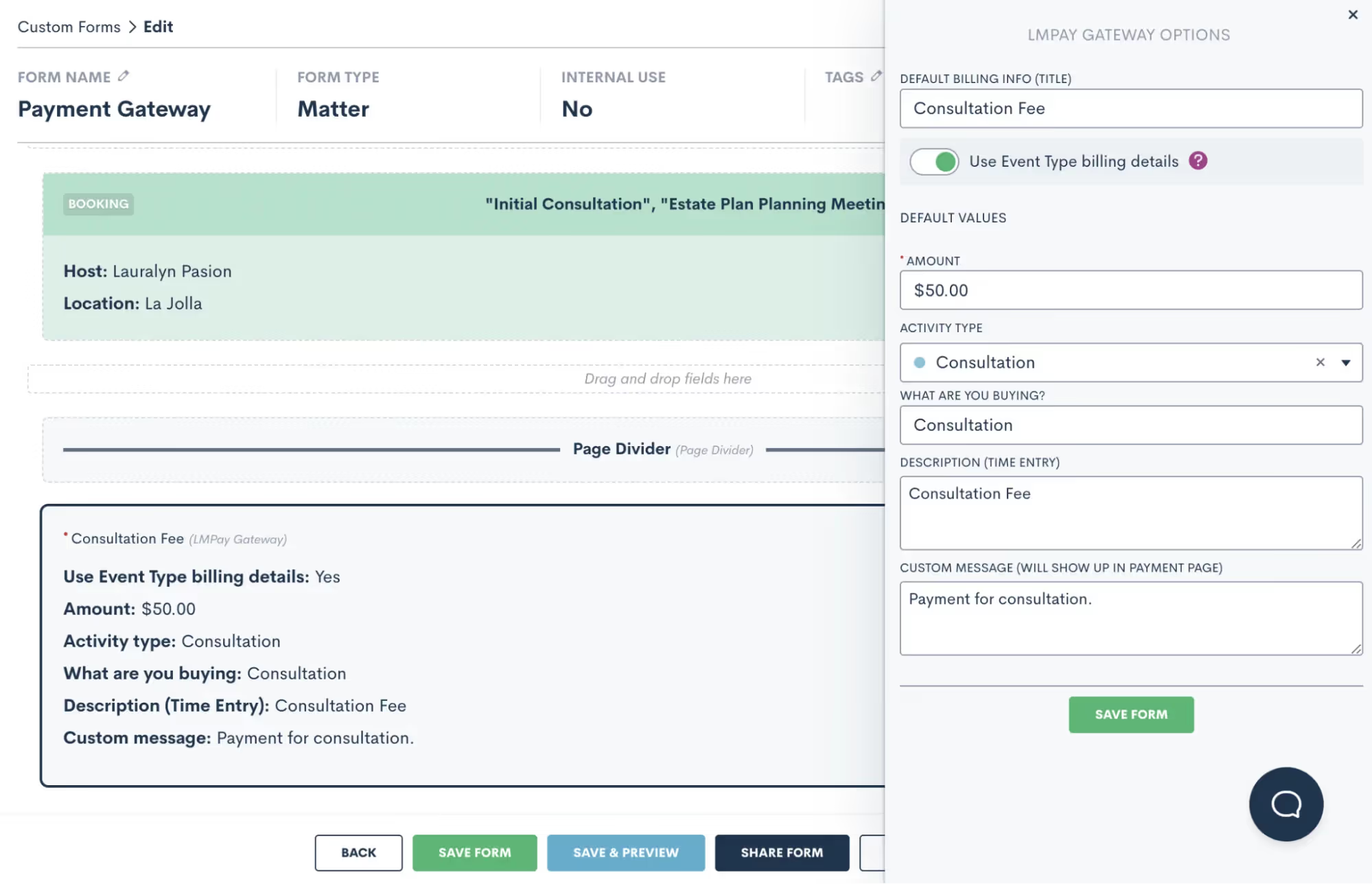
You can easily specify the amount, activity type, etc for this payment (pictured above). When the potential client fills out this form, they are able to select a time for their consultation and enter their payment details to pay your consult fee.
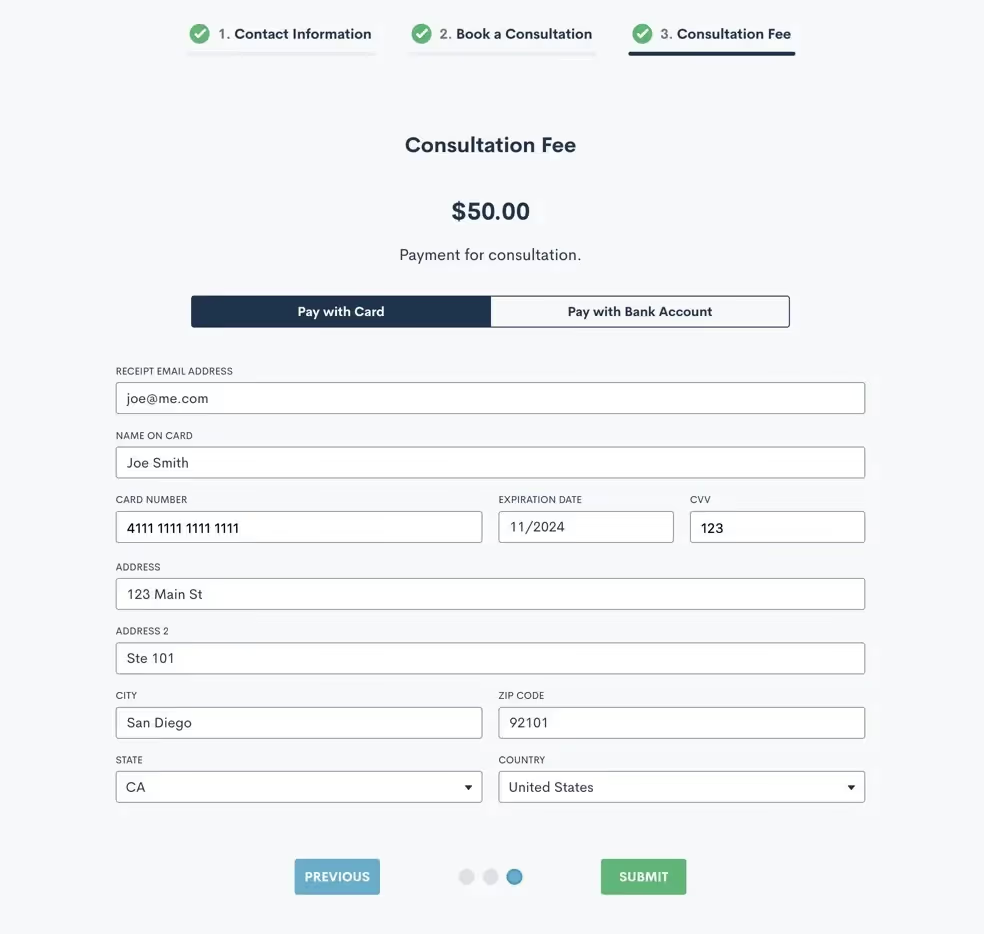
Any payments made via LMPay are tracked in Lawmatics and visible on the matter’s profile. Click on the Billing tab to view invoices as well as payment history for that particular matter.
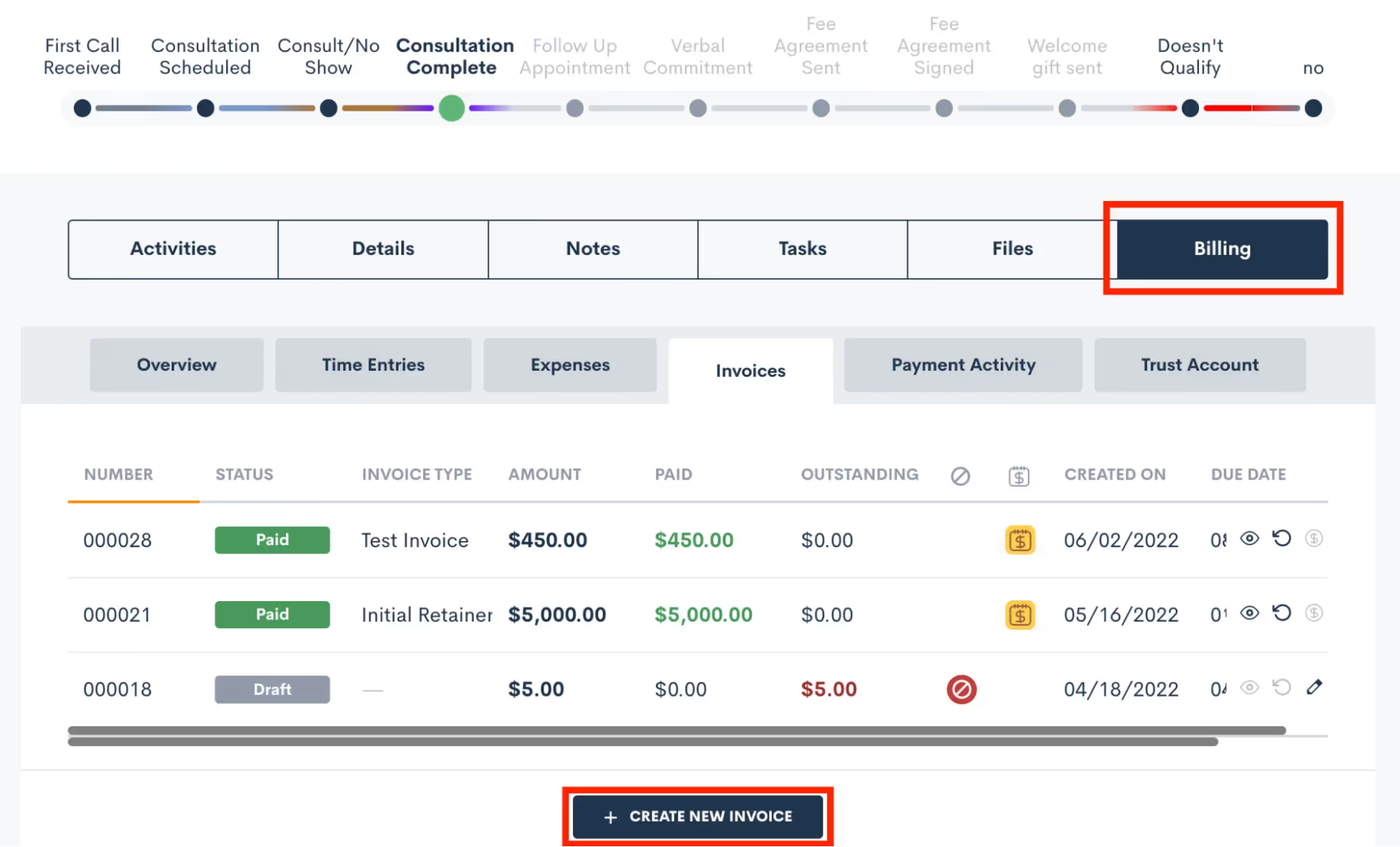
NEW Billing Tab
You will also have access to a separate Billing tab on the main menu of your Lawmatics window, located at the very top of any page. Here you will find an overview of all invoices and payments for the firm, as opposed to zeroing in on a specific matter.
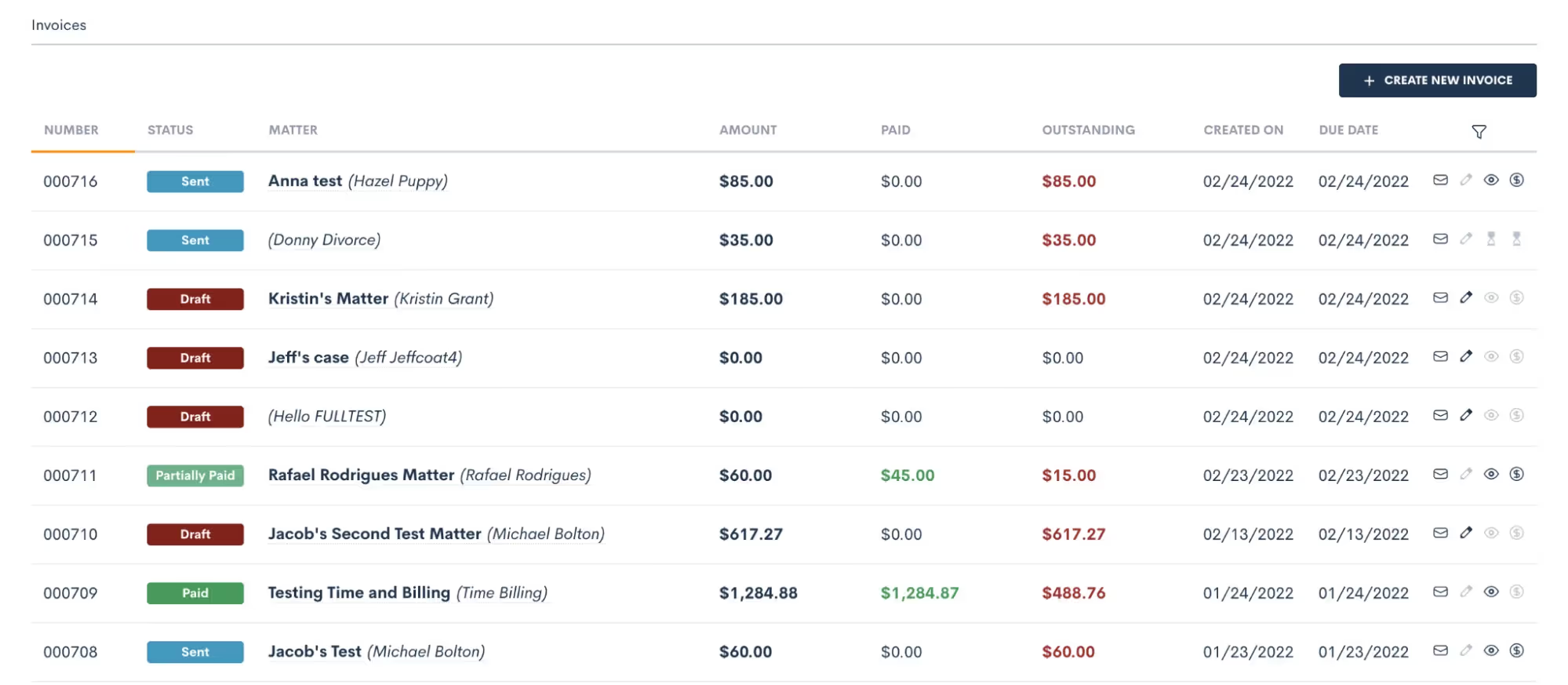
Easily view, sort, and filter your invoices or create a new invoice manually if needed.
Time & Billing
Whereas LMPay is geared towards collecting consultation fees, the Time & Billing add-on offers an entire suite of time and billing features. Even if you currently use a case management system for this functionality, you’ll find that Lawmatics has everything you need under one roof.
Getting Started
To begin using Time & Billing, you will need to do the following:
- Email support@lawmatics.com to notify our team that you would like to activate Time & Billing. Time & billing does come at an additional cost per user to your Lawmatics subscription.
- Let us know which of your Lawmatics users you would like to access. You are only charged the add-on rate for the users that need to access the feature.
- Once Time & Billing is activated, configure your settings. This includes setting up your expense types, default hourly rates, payment receipt email template, and more.
Time Tracking
Lawmatics makes it easier than ever to track your time spent on various billable and non-billable activities. Once you have activated the Time & Billing add-on, a Time Tracker will appear in the top menu of your Lawmatics account. Click the Time Tracker to select the matter you intend to track time for as well as the activity type for this session. Then click the Play button (shown below) to begin tracking your time.

All sessions will automatically log on the corresponding matter and can be invoiced when ready.
Expenses
There are two ways to log your expenses in Lawmatics. You can either go to the Expenses page under the main Billing tab or navigate directly to the matter to which the expense pertains. Upon creating an expense, you will be prompted to select the staff person from your list of users, the activity type, as well as the quantity (when applicable).
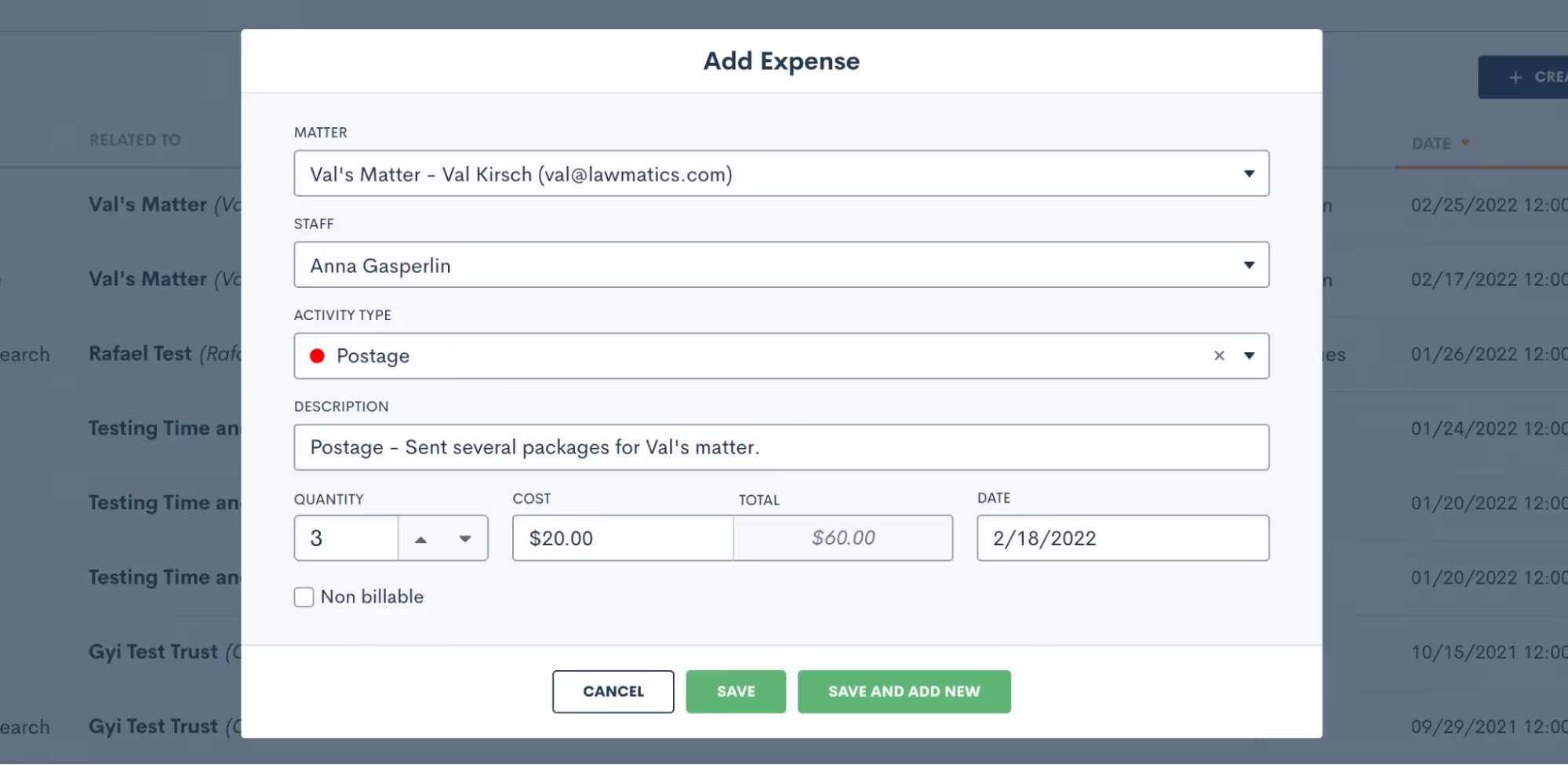
Invoices
As you begin tracking your time and expenses, the time will come to invoice a matter and receive your payment. Here’s how:
- Create the Invoice either from the main Invoices page or from the matter’s profile directly. If creating an invoice from the main page, you will first need to select which matter you are invoicing.
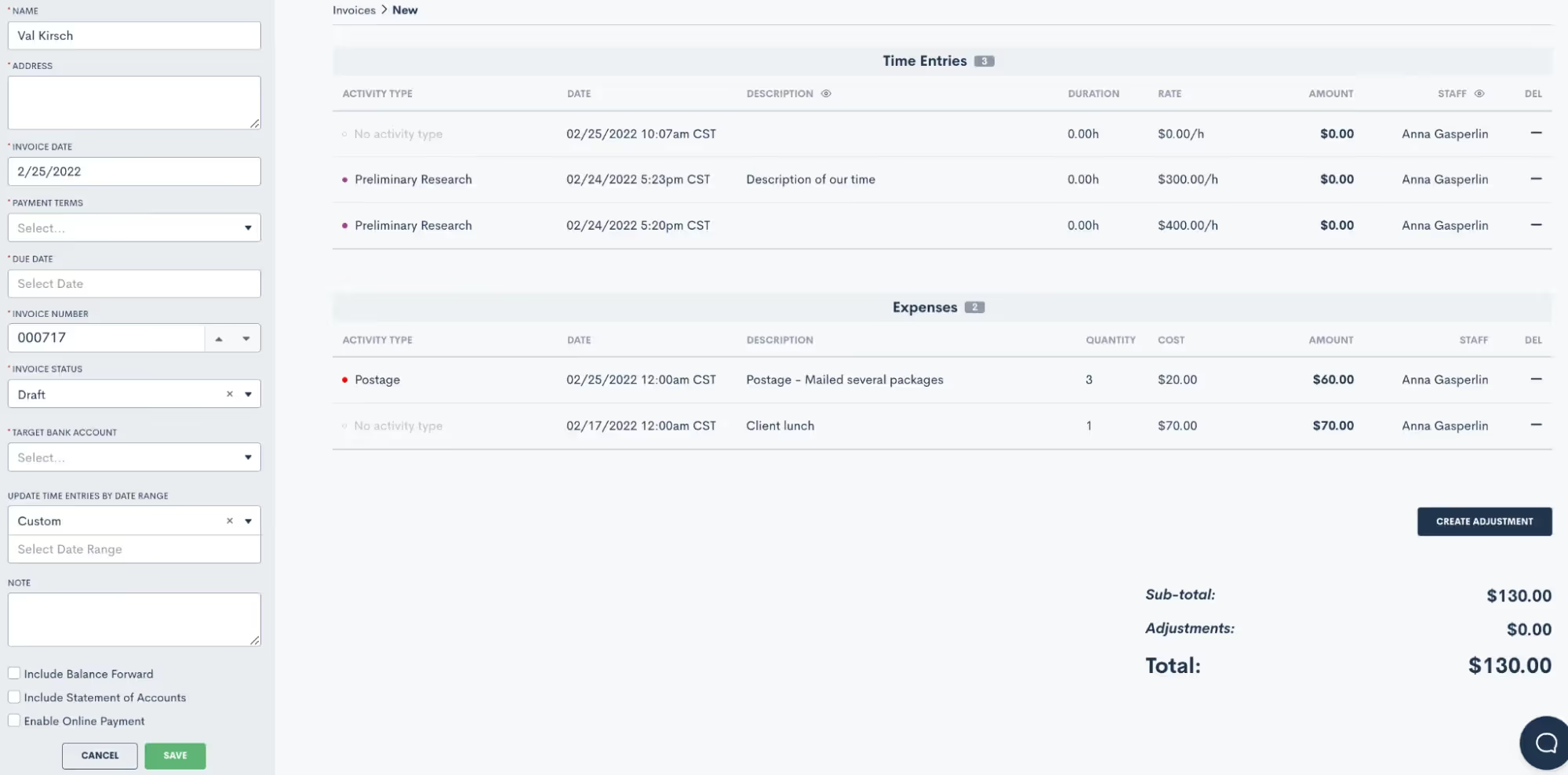
- Select which time entries and expenses to include, as well as all of your payment terms and options shown on the left sidebar above.
- Create the invoice as a draft and then send it from the invoices page or the matter’s profile once you are ready.
We suggest selecting the option to Enable Online Payment so that your clients can easily make their payment online via card if they would like.When you send the invoice, the client will receive an email with their invoice attached, similar to the sample invoice shown below.
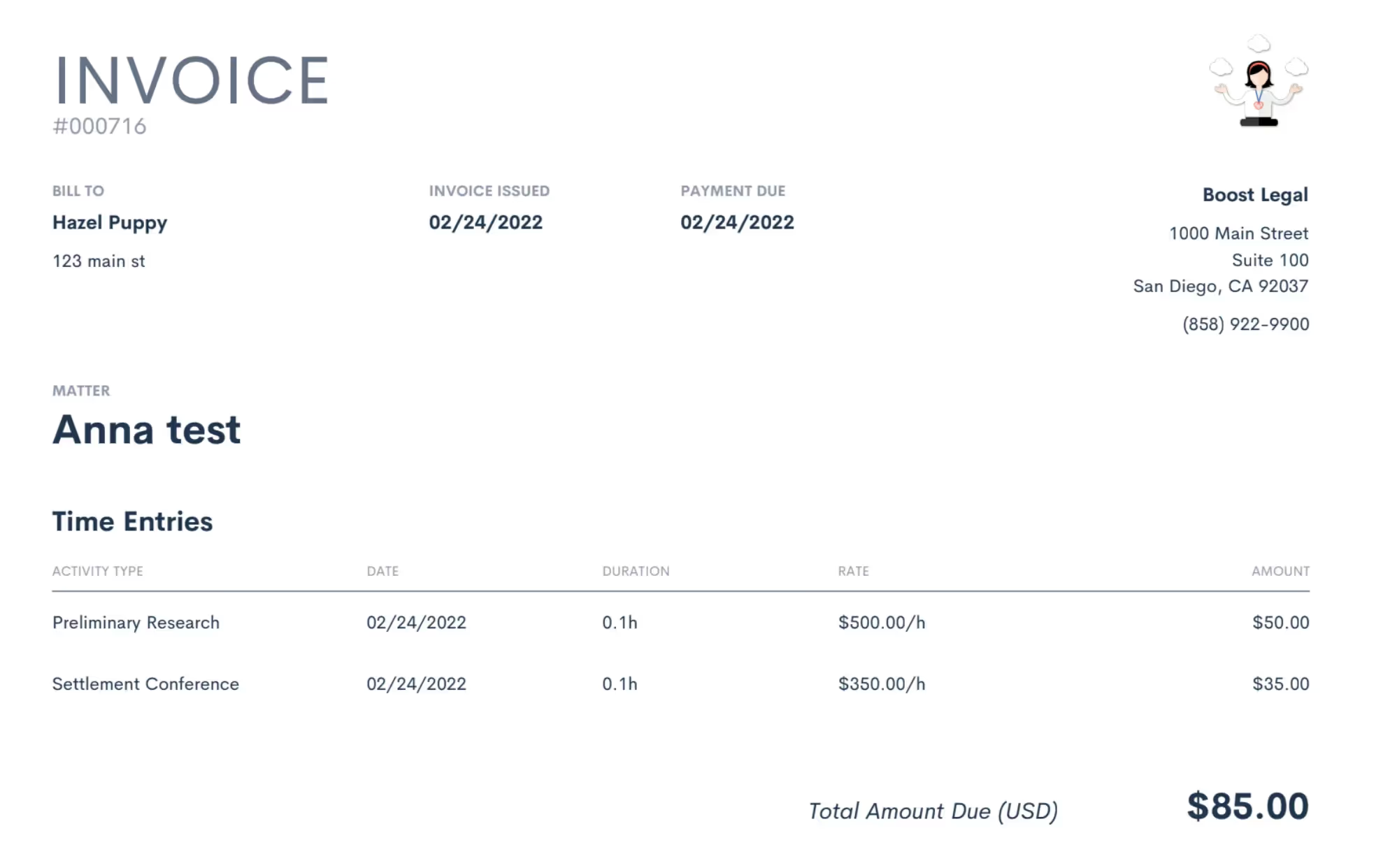
If a client opts to pay via online payment, then the invoice will automatically move from “Sent” to “Paid accordingly”. If payment is accepted offline, you can simply return to the invoices page or the matter profile to mark the invoice as paid when necessary.Lawmatics also give you the option to create a custom payment plan for an invoice as needed by selecting the option to allow installments.
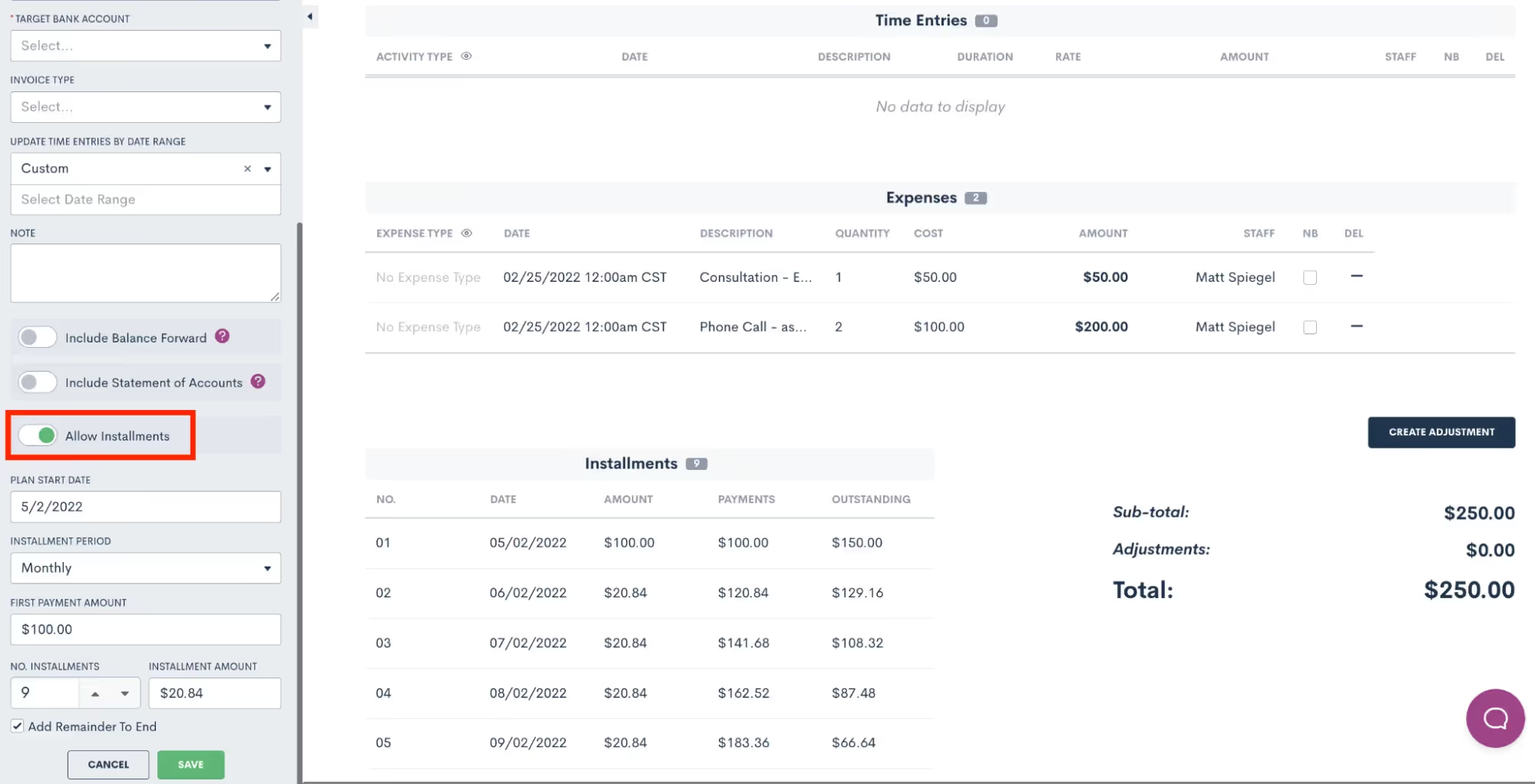
Trust Accounting
Lawmatics also handles your trust account for each matter. You will find a summary of your firm’s trust accounting under the main Billing tab at the top of your account or within a matter’s profile, after which you will select the Trust Account section on their specific Billing tab.

Here you can manage trust balance transfers, refunds, trust deposits, and set a minimum trust balance alert when needed. You will also find a summary log of all trust requests for this matter.
Reporting
When using Lawmatics Time & Billing, you have access to several reports for keeping tabs on your payments and history.
Hours Billed Report
The Hours Billed report keeps track of all hours logged for each user in your system.

Accounts Receivable Report
The Accounts Receivable report displays outstanding balances to give you a sense of expected cash inflow.

Payment Activity Report
From consultation fees to retainer payments, view a log of all payment activity on your account.

Remember, these features are only available for users with the time & billing add-on. You won’t find the full gambit of billing capabilities with LMPay. Feel free to email support@lawmatics.com with any questions or to add time & billing to your account.
Quickbooks Integration
Lawmatics integrates your invoices directly with Quickbooks. Use this integration to automatically create a customer and invoice in Quickbooks when an invoice is sent to a matter via Lawmatics. Here’s how to begin using the Quickbooks integration with Lawmatics:
- Go to your firm's Settings and select Integrations from the left sidebar.
- Click on Quickbooks.
- Connect your account using the guided prompts.
- Once your account is connected, you will then need to map your accounts, default types, time entries, and expenses to ensure that pertinent matter data syncs from Lawmatics to Quickbooks. Make your selections accordingly.
- Click Save Mapping. Note that you can come back and adjust these any time.
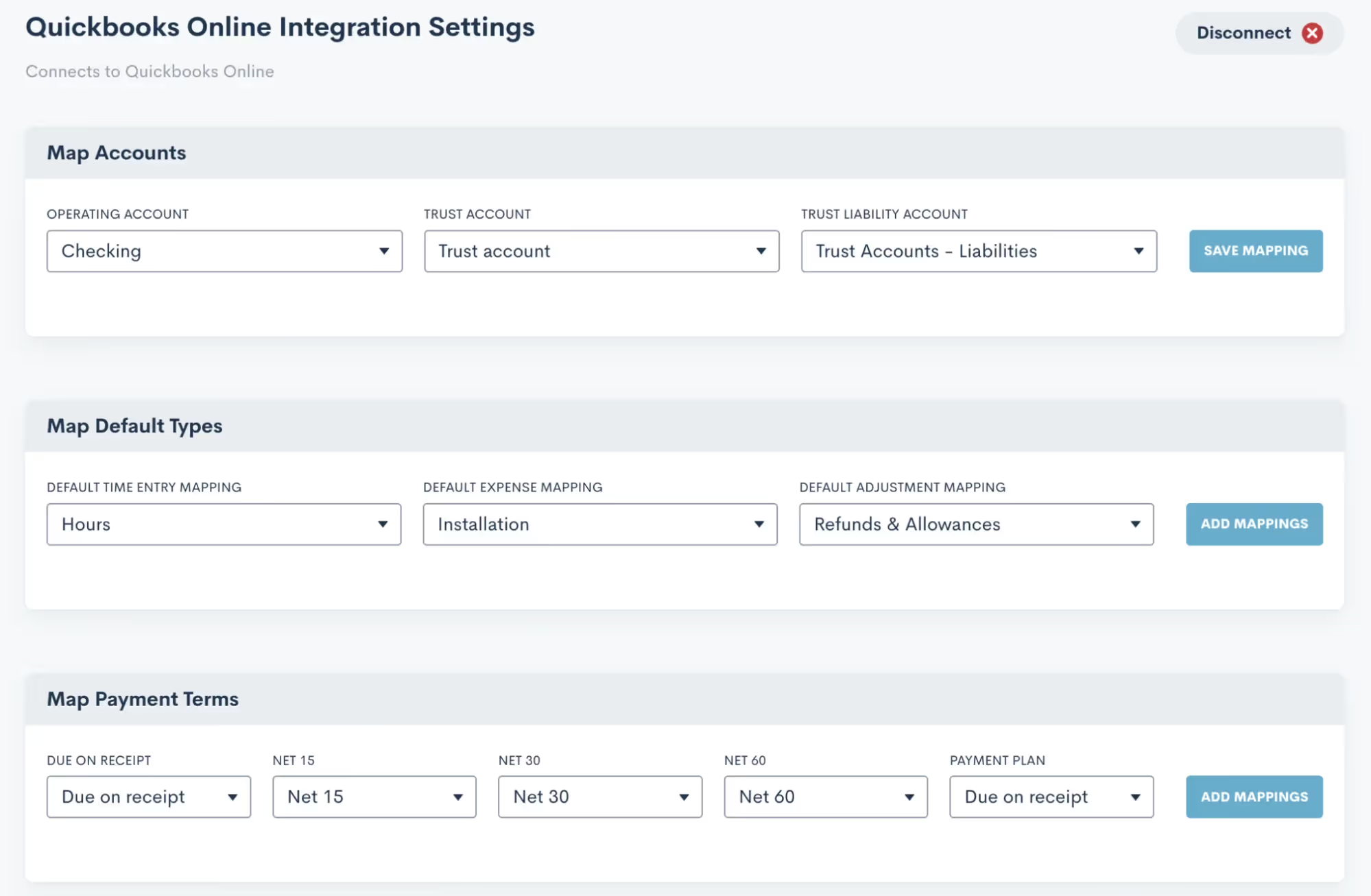
To sync an invoice, simply send it to a matter through Lawmatics as you normally would, then click the Sync to Quickbooks option as shown below.

This integration is a one-way sync, pushing data from Lawmatics to Quickbooks. The customer and invoice will be created in Quickbooks, along with any other details you have mapped when you opt to sync the invoice. Additionally, when the customer is created in Quickbooks upon sync you will see "Lawmatics" along with the matter ID added to the last name
Automation
Create Invoices
Keeping in tune with the overall goal of Lawmatics, many of the features we have gone through so far can be used within your automations. First of all, you will find the Create Invoice action item which can be used for creating and sending a Lawmatics invoice automatically.
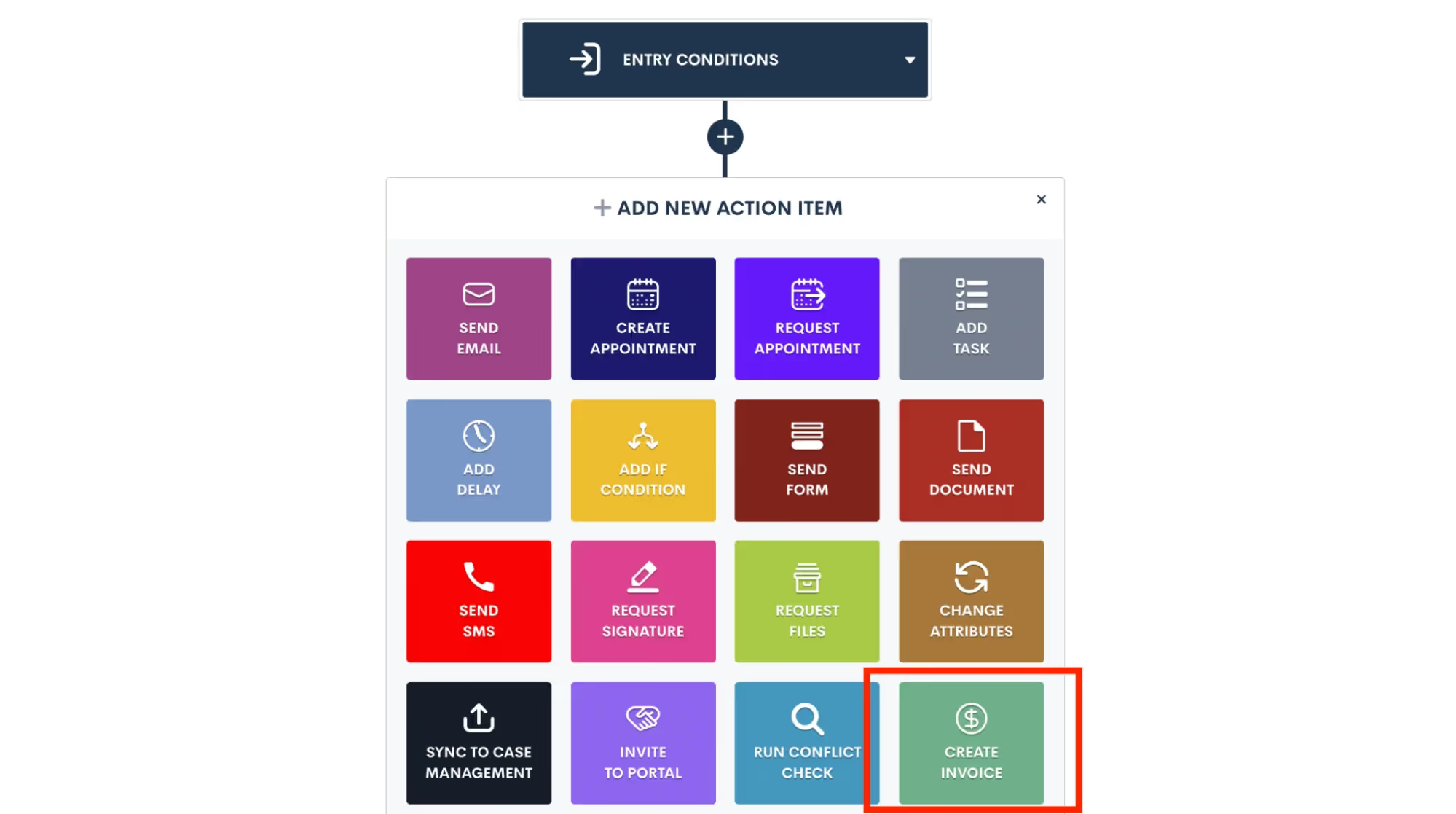
When using this action you will select your payment terms and other options as part of the automation template, just like you would do if you were sending an invoice as a one-off.
Trigger Actions Upon Payment
Additionally, you can trigger an automation when an invoice is paid. So for example, you may send out your retainer agreement for e-signature along with your retainer invoice for payment. You could then have an automation that triggers when both the document is signed and the invoice is paid for kicking off the next step in your process.
Invoice Payment Reminders
Another great way to add automation to your invoicing process is to set up invoice payment reminders. This option allows you to have an automatic email sent out, at the timing of your choosing, for any invoices that are not yet paid before their due date. Have the reminder sent the week before, the day before, or whatever other timeframe you would like.
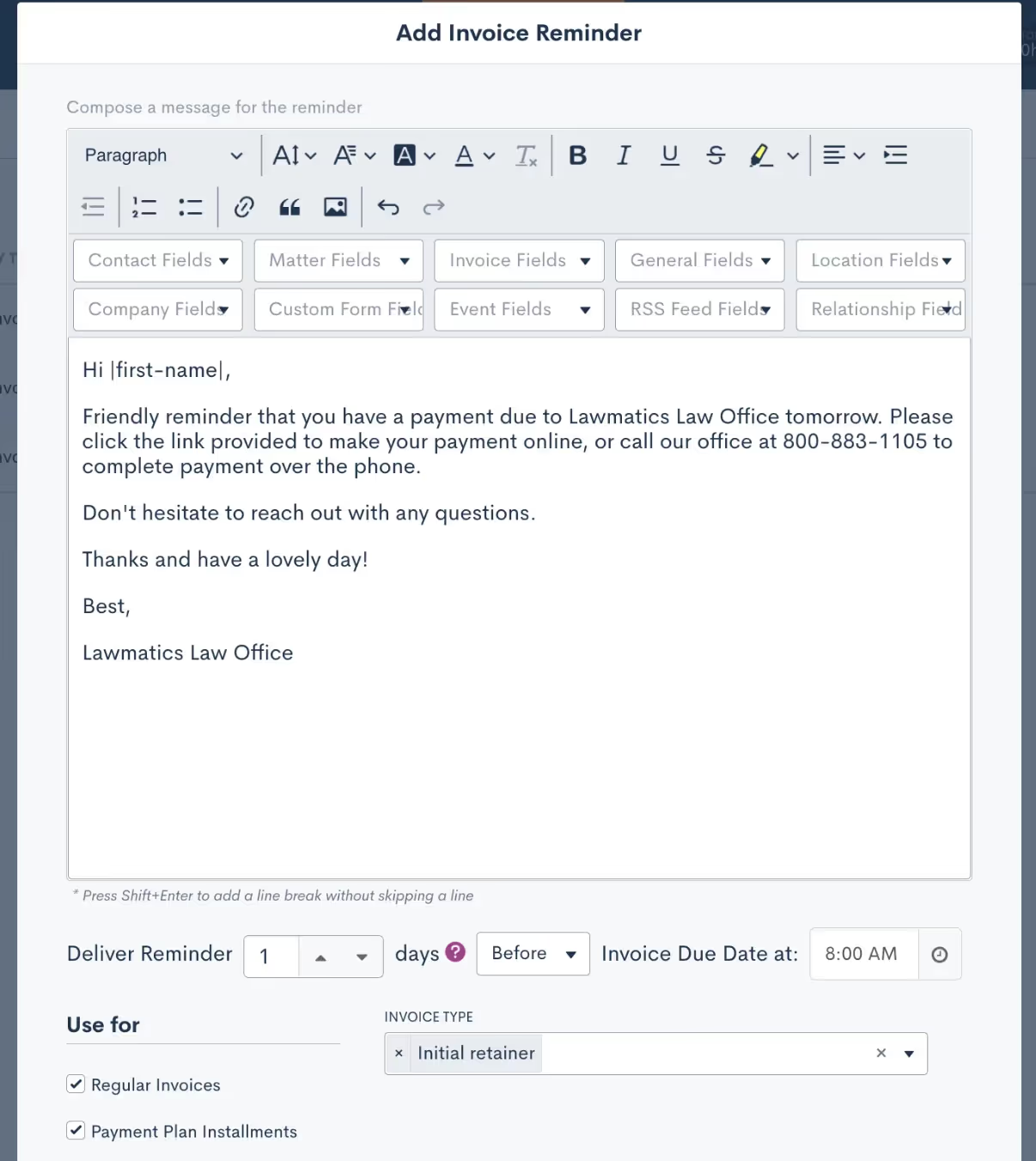
As shown above, you can also create your own custom email template for these reminders. No need to build an automation for this, simply set up the template on your Invoices page in settings and it will automatically go out at the timing of your choosing.
Conclusion
In summary, whether you are looking for the complete package of time & billing features or a simpler solution focusing on consultation payments, Lawmatics has what you need to access this functionality directly in your CRM.Most importantly, Lawmatics helps you collect your payments easily and quickly, creating a smooth experience for both you and your clients. These features work into your automations seamlessly, so you can set a workflow and forget it, knowing that it will run like a well-oiled machine.Unlike other platforms that only have one function, such as Calendly or Acuity for paid bookings or Lawpay to take payments, when you schedule paid consultations through Lawmatics you are keeping the entire process, from start to finish, in one platform.
According to Gartner, customer relationship management (CRM) is the largest and fastest-growing enterprise application software category. Worldwide spending on CRM is expected to reach $114.4 billion by 2027. So what is CRM, and what does it have to do with marketing?
What is CRM in marketing?
Customer relationship management (CRM) is a technology used to manage a company’s relationships and interactions with customers and potential customers. The goal: to enhance business relationships and grow the business. An attorney CRM software, for instance, allows law firms to stay connected to clients and prospects, simplify processes, and boost profitability.The term CRM typically refers to a CRM system, a technology tool that supports contact management, sales, productivity, and more. CRM tools manage relationships across the entire customer lifecycle, including marketing, sales, digital commerce, and customer service interactions.A CRM solution helps an organization focus on its relationships with people – customers, colleagues, vendors, and suppliers — throughout their interactions with them, including finding and engaging new customers, winning their business, and providing support and additional services throughout the relationship.
What are the types of CRM?
There are several types of CRM, and organizations must understand the differences between them to determine the right option. The 4 types of CRM systems include:
- Operational CRM. The most common type of CRM is the operational CRM, which performs the broadest range of functions. Operational CRM streamlines the various processes utilized when building customer relationships and applies them to the central business process. These platforms help companies generate leads, convert them into contacts, and provide the infrastructure necessary to retain customers. In addition, operational CRM systems seize customer details and use them to provide superior service through marketing, sales, and service automation. Some common examples of operational CRMs include Mailchimp, HubSpot, and Salesforce.
- Analytical CRM. This CRM type leverages customer data into trends and insights that enable organizations to improve customer experience. They are good options for mid to large-size companies that collect vast amounts of data and want to condense it into actionable information. Two examples of analytical CRMs include:
- Salesforce CRM Analytics: a part of Salesforce CRM that provides data visualization
- Zendesk Explore: reporting and analytics software that imports data from support and service options to help organizations gauge and improve customer service
- Collaborative CRM. This focuses on customer service. Collaborative CRM systems bridge the gap between teams and departments, enabling various groups or areas within an organization to share customer data to make decisions and manage customer relationships. Some examples of collaborative CRMs include Microsoft Dynamics 365, a suite of tools for B2B organizations, and Copper, a collaborative CRM that integrates with Google Workspace to allow small businesses to use a central hub to access customer data.
- Strategic CRM. This type of CRM specializes in long-term or ongoing customer relationships. A number of common features of a strategic CRM intersect with those of collaborative CRMs, like data regarding prior interactions with a particular customer. If the success of your law firm is contingent on repeat clients, a strategic CRM can help you identify why a client keeps coming back. The benefits of a strategic CRM are in its ability to form the foundation of data-driven marketing and operations strategies, offering insights into areas like marketing, sales, and customer service over the course of a client’s relationship with you.
When choosing a CRM system, organizations should identify needs and priorities, determine essential features, assess the vendors’ vision, viability, and support, and compare deployment and purchasing options.
What are the benefits of CRM in marketing?
CRM platforms provide many benefits to marketers, including:
Personalized marketing
Organizations with practical customer experience frequently tailor their service and marketing efforts to individual customers and segments of customers. This personalized approach can increase customer satisfaction and sales; however, it can only be provided if organizations track necessary data. CRM platforms record vital customer information such as demographics, purchase history, and customer service interactions. Equipped with this information, these platforms can perform targeted advertising.
Increased productivity
Organizations can streamline workflows by integrating their CRM platforms with other tools, such as calendar and electronic signature applications. For example, suppose an organization integrates its CRM platform with its e-signature application. In that case, the system automatically populates forms containing customer information – name, phone number, address, email, and more – from the CRM's repository. CRM integrations can also increase productivity. For example, if a CRM platform is integrated with an organization’s email and calendar apps, agents can view sales pipelines, customer interactions, and upcoming appointments in one central location.
Artificial intelligence
Organizations can use CRM platforms to obtain critical business insights through artificial intelligence (AI). For example, CRM platforms with forecasting tools have the ability to detect trends in customer data and provide sales agents with recommendations regarding actions to take. In addition, some AI-powered CRM systems use sentiment analysis tools to discern customers' emotions during a given interaction.
What legal CRM should my law firm choose to automate marketing efforts?
Lawmatics is the logical choice for organizations that want to attract more prospects, win more clients, automate the leg work of their marketing efforts, and drive growth. Lawmatics law firm marketing automation enables growing law firms to seize every new client opportunity with targeted messaging and impeccable timing. It allows them to guide leads through a seamless journey from potential lead to happy client. For more information on how Lawmatics can turbocharge your marketing efforts, get a demo today.
Subscribe to get our best content in your inbox
Ready to grow your law firm with Lawmatics?
Schedule a demo of legal’s most trusted growth platform.
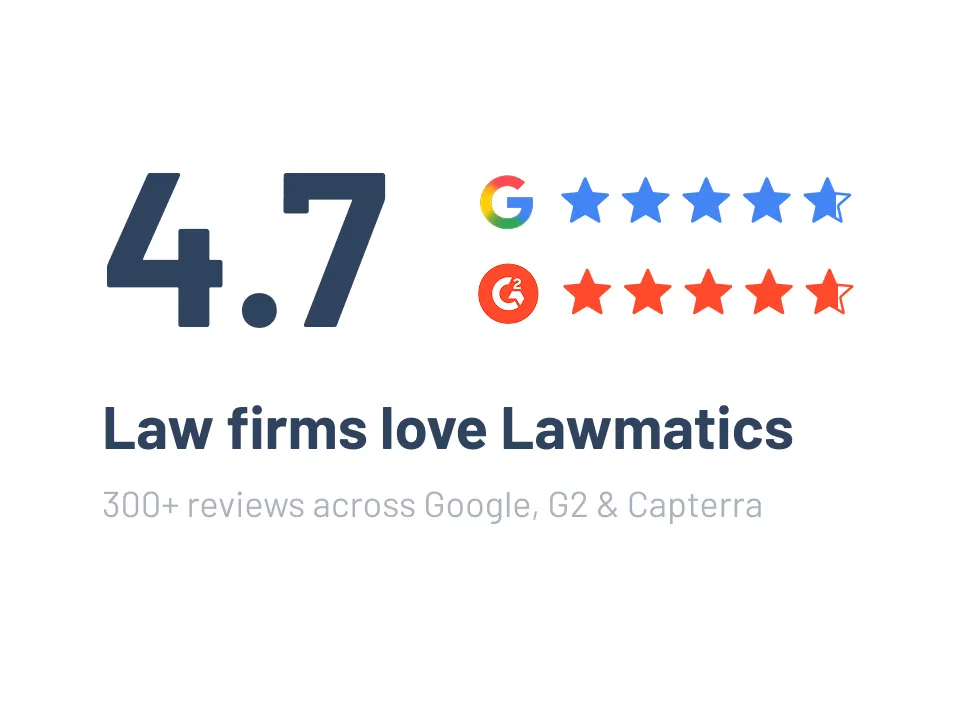




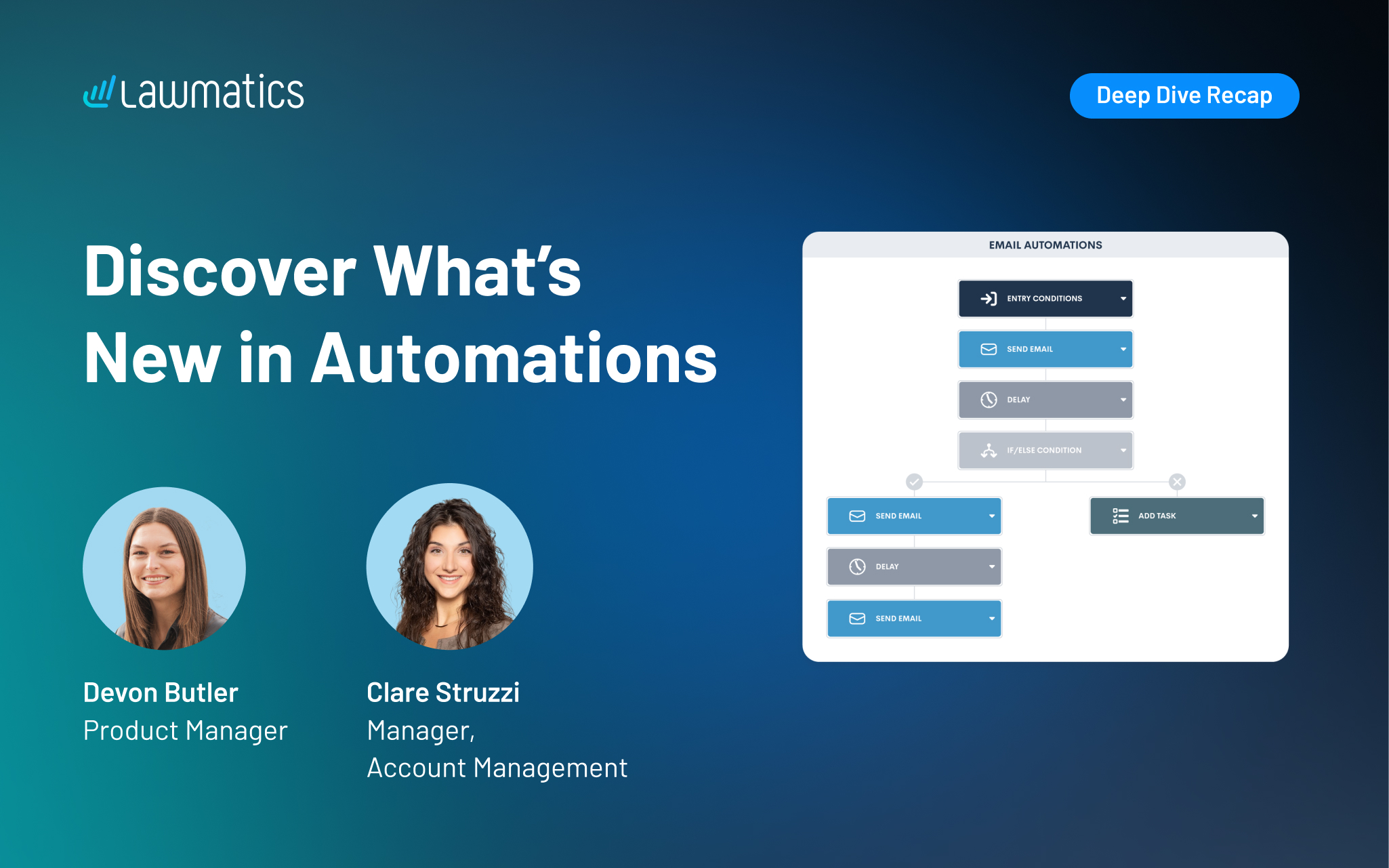


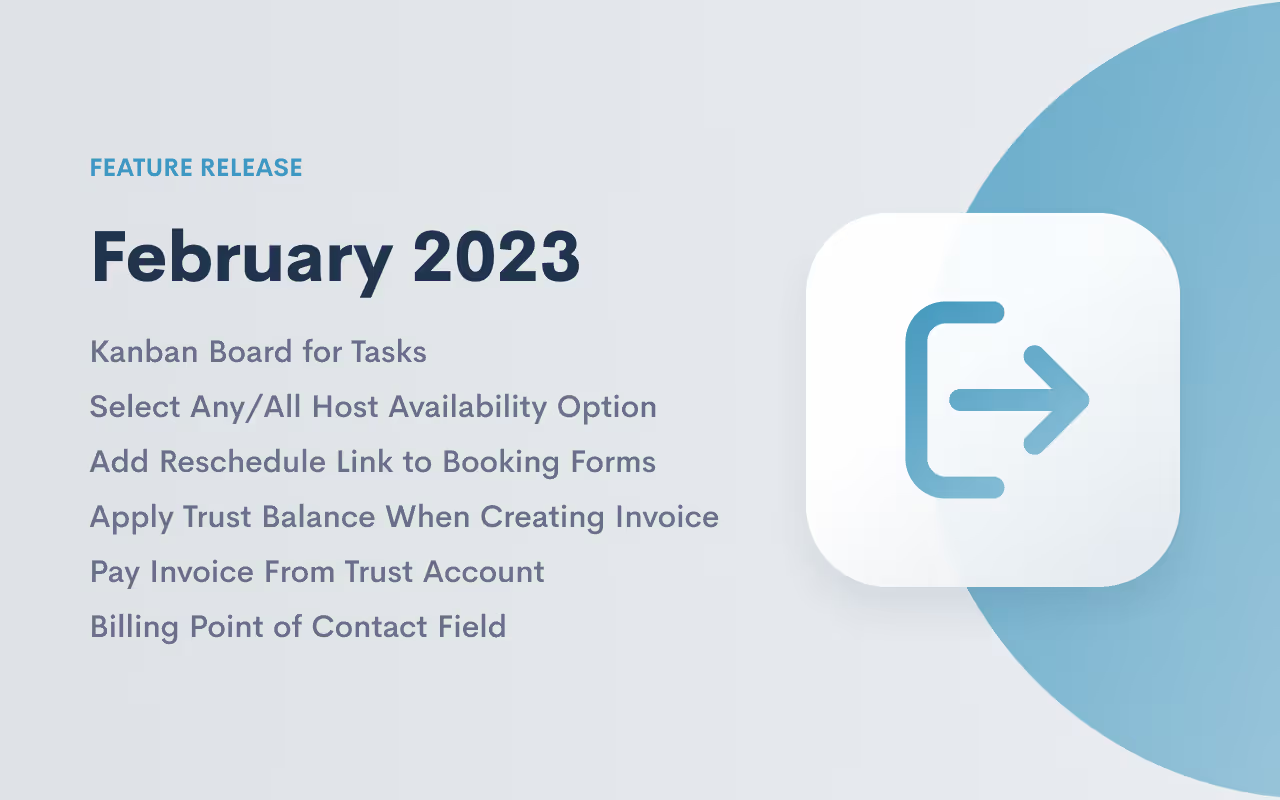
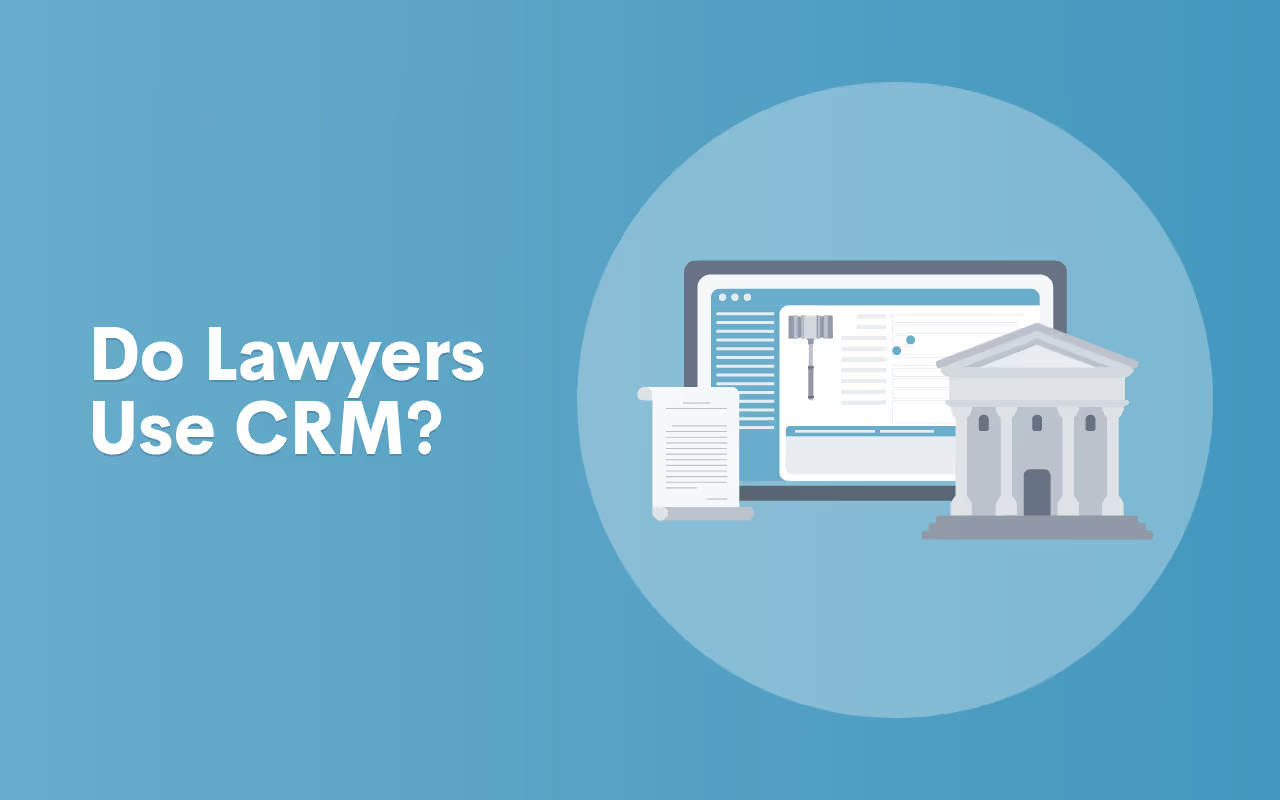
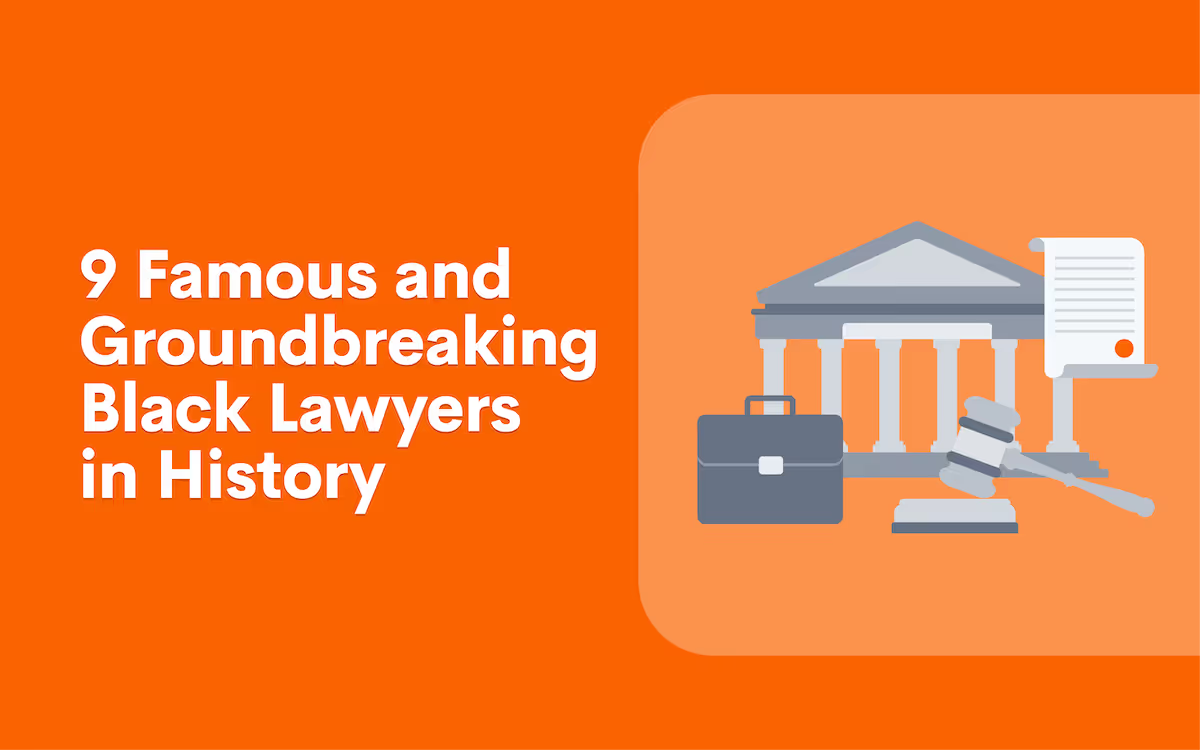

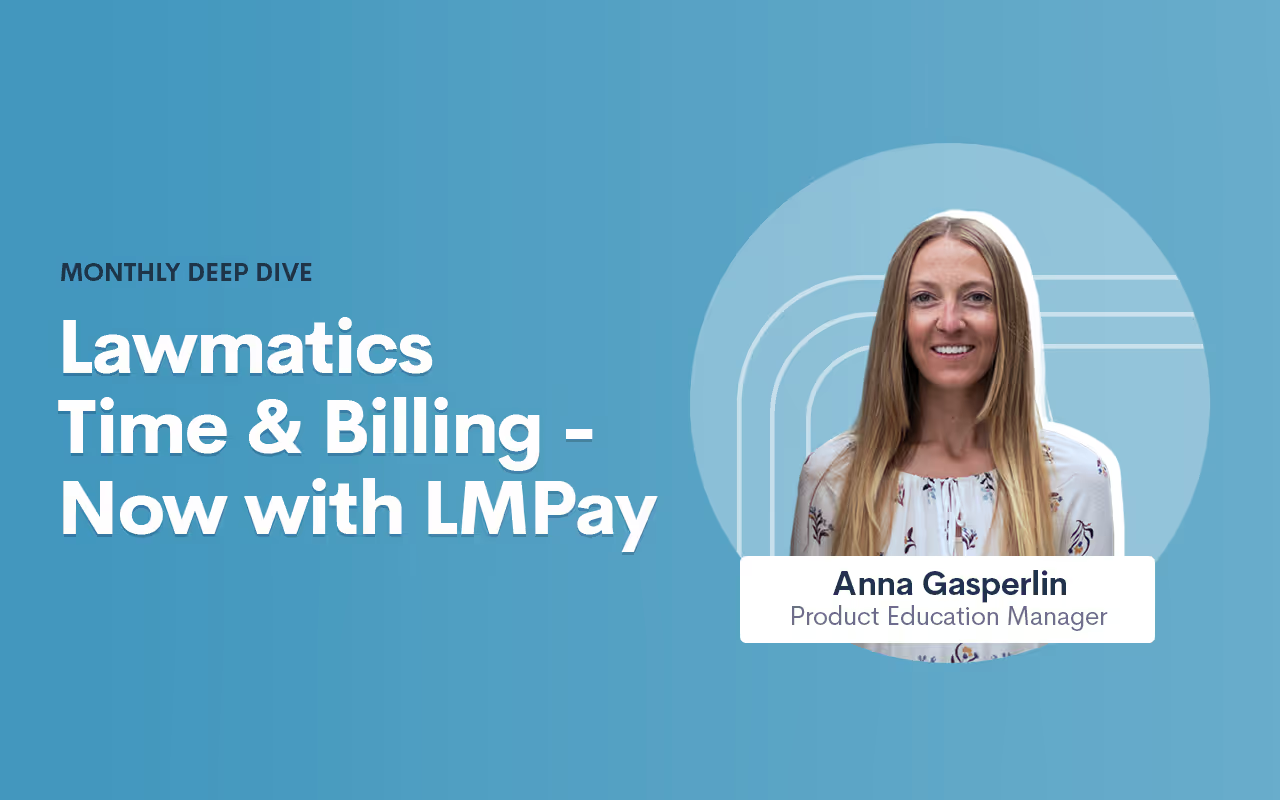
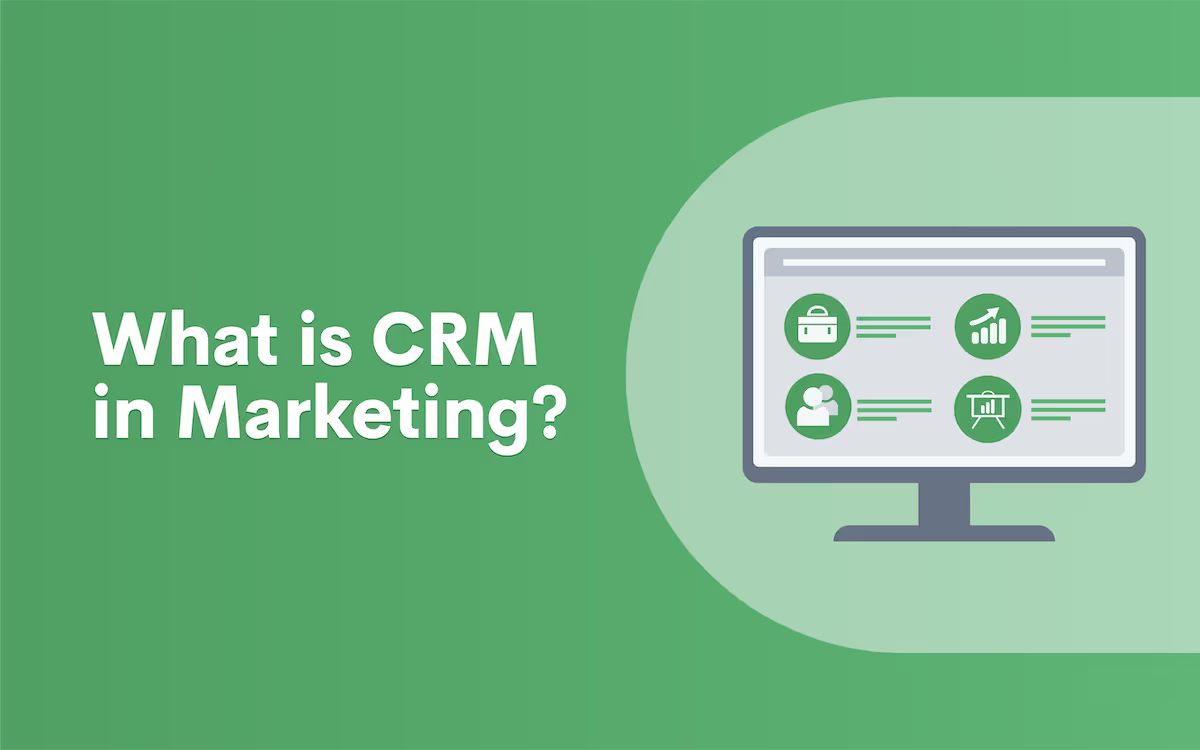
.avif)
.avif)

.avif)
